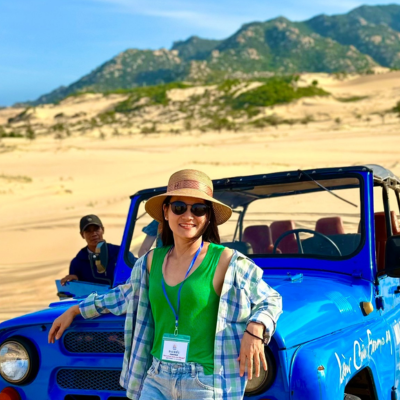30 Days in Thailand, Vietnam, and Cambodia
This 30 days’ tour from Vietnam to Cambodia and Thailand is designed for those who want to see the best of these three countries from the history, culture, to the local authentic lifestyle of the local people. Starting from Thailand, then fly to Hanoi, travel down south to Ho Chi Minh, take a speed boat to cross the border to Cambodia and the tour ends in Cambodia. A lot of must-see places, world heritage sites in just 30 days.
- 9 Days in Thailand
- Day 1: Bangkok Arrival
- Day 2: Bangkok City Tour
- Day 3: Bangkok Full-Day Floating Market and River Kwai
- Day 4: Bangkok - Ayutthaya - Lopburi - Phitsanuloke
- Day 5: Phitsanuloke - Sukhothai - Chiang Rai
- Day 6: Chiang Rai - Golden Triangle - Chiang Sean
- Day 7: Chiang Rai - Chiang Mai
- Day 8: Chiang Mai - The Elephant - Orchid & Butterfly Farm
- Day 9: Chiang Mai - Bangkok - Fly to Hanoi
- 16 days in Vietnam
- Day 10: Hanoi City Tour Half Day - Night Train to Lao Cai
- Day 11: Lao Cai - Sapa - Lao Chai - Ta Van
- Day 12: Sapa - Cat Cat - Sin Chai - Hanoi
- Day 13: Hanoi - Hoa Lu & Tam Coc (Ninh Binh) - Hanoi
- Day 14: Hanoi - Halong Bay - Overnight on Cruise
- Day 15: Halong Bay - Hanoi - Fly to Hue
- Day 16: Hue Half-Day City Tour
- Day 17: Hue - Da Nang - Hoi An - Road transfer
- Day 18: Hoi An Half-day City Tour
- Day 19: Da Nang - Train to Nha Trang
- Day 20 - 21: Nha Trang Free Days
- Day 22: Nha Trang - Overnight Train to Ho Chi Minh
- Day 23: Ho Chi Minh City Half-day City Tour
- Day 24: Ho Chi Minh City - Cai Be - Can Tho
- Day 25: Can Tho - Cai Rang Floating Market - Chau Doc
- 5 days in Cambodia
There is a land that shares the boundaries of China to the east and India to the west and most of the people in this land are Buddhists. That land is called Indochina. Three of the most awesome countries in the region are Vietnam, Cambodia, and Thailand. A tour of these three countries is designed to take you from Thailand, one of Southeast Asia's oldest nations but a fabulous destination with palaces, temples, markets, shopping, spas, and friendly people to Cambodia with long and culturally rich historical background, famous for its Angkor complex or Vietnam with the incredible hill tribes, colorful floating market, Halong Bay - World Heritage Site. You will not only travel, but also have a chance to enjoy the stunning natural scenery, and experience the vibrant and diverse cultures, but also you can interact with local people, and enjoy the local food. There are a lot of things to see and do in these three countries in 30 days. Travel with us and you may think you need more than 30 days.
9 Days in Thailand
Day 1: Bangkok Arrival
Flight to Bangkok is often cheap than in other cities, which is the reason why Bangkok becomes one of the biggest arrival airports for international tourists. It is a great idea to start your 30 days trip to Thailand, Vietnam, and Cambodia in Bangkok. From the airport, you get transferred to the center of Bangkok. A night in the city center for relaxing and recovering after a long flight.
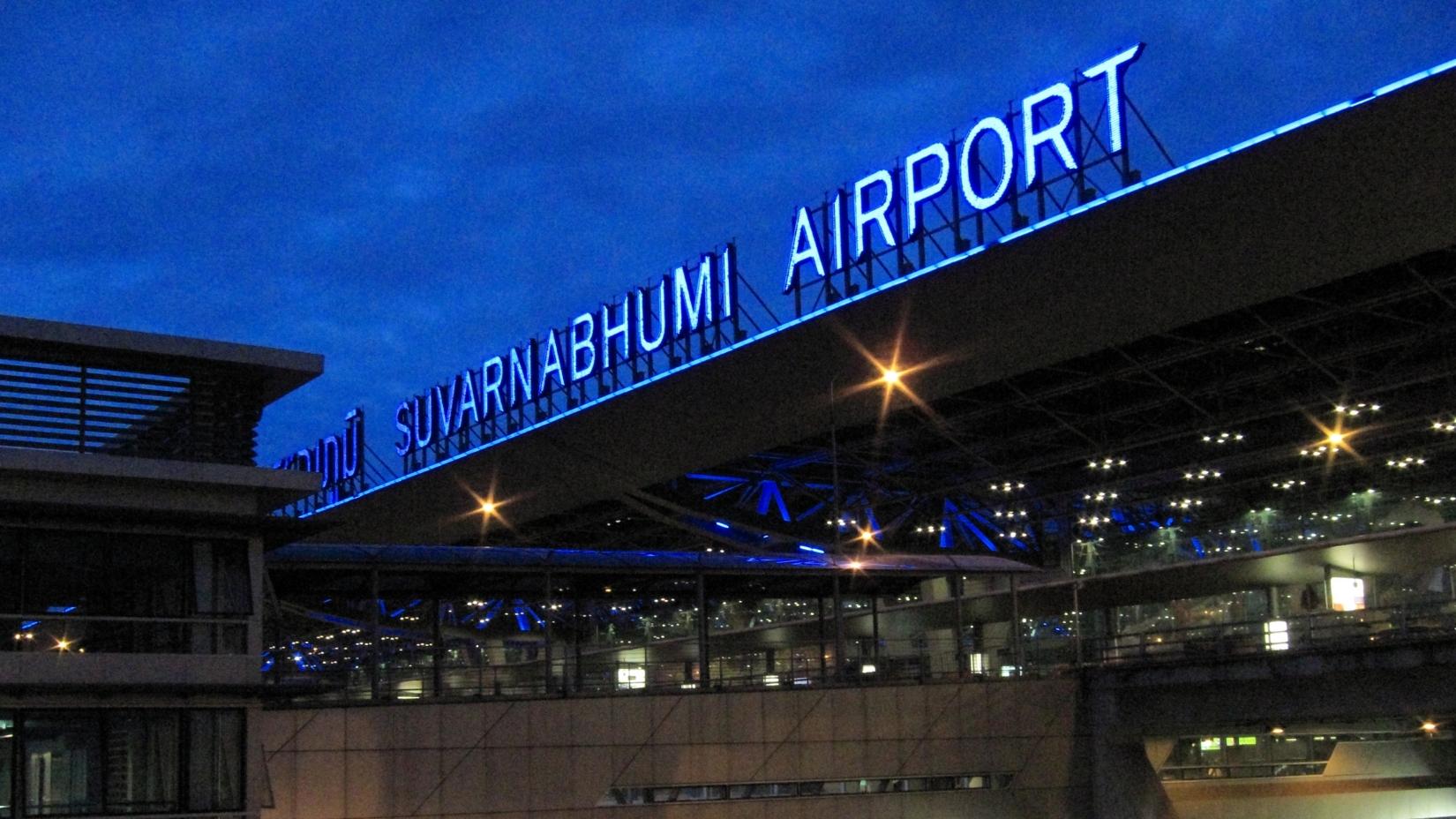
Welcome to Thailand
Day 2: Bangkok City Tour
Today is the day to start your city tour in Bangkok, the capital of Thailand. Thailand is a land of culture and customs, full of temples and palaces and your trip to Thailand is incomplete without a visit to temples and palaces. Bellow are recommended temples and palaces for you to visit.
Wat Traimit
Located in Chinatown, Wat Traimit is a Royal temple famous for the enormous gold Buddha image, the world’s largest solid gold Buddha image. It is a 3m-tall, 5.5-tonne solid-gold Buddha image. The 2nd floor of the building is a museum with multimedia exhibits on the history of Bangkok's Chinatown and its residents while the 3rd floor exhibits how the statue was made.
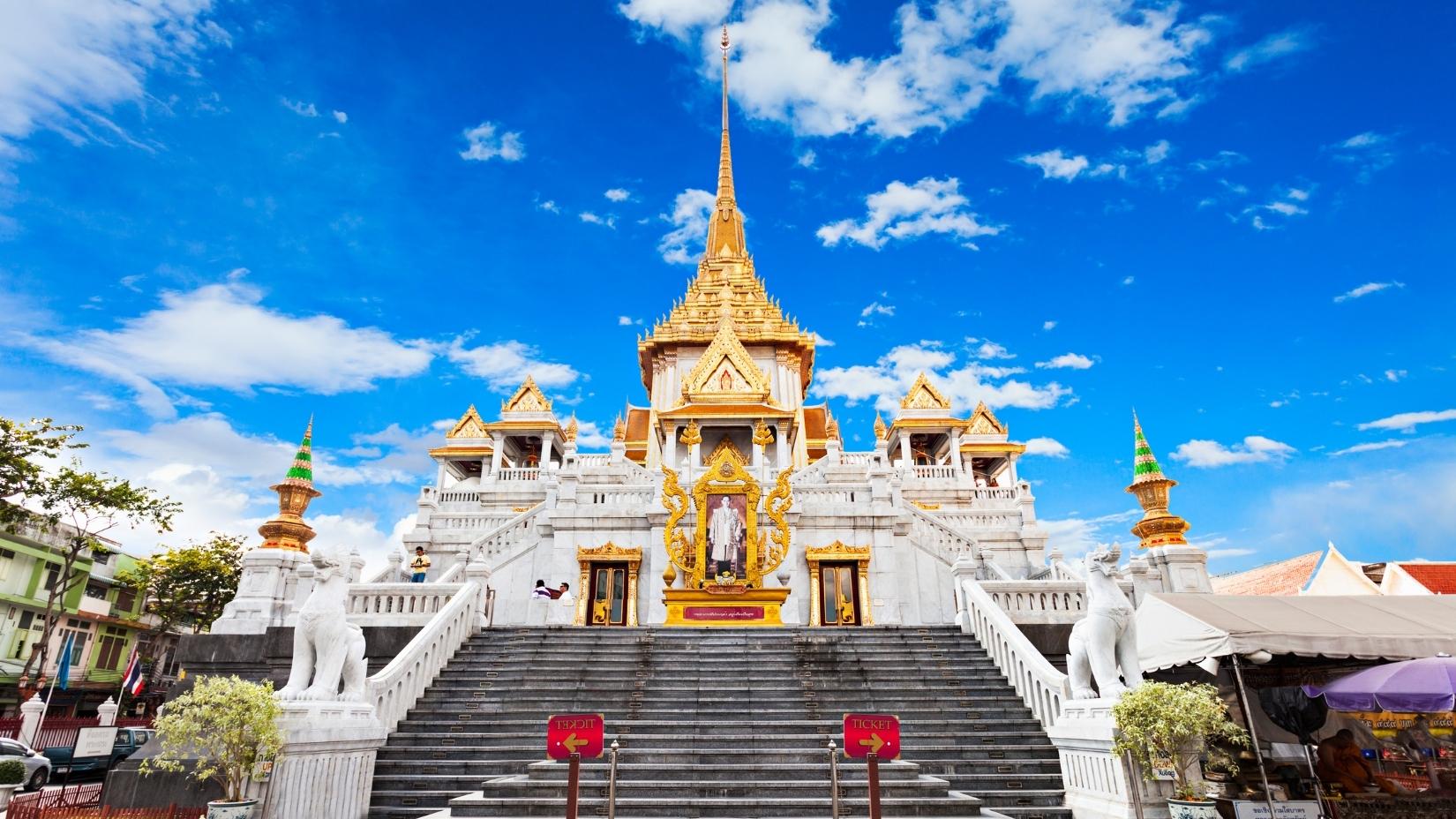
Wat Traimit
Wat Pho
Other names of Wat Pho are the Temple of the Reclining Buddha or Wat Phra Chetuphon. It is one of the largest temple complexes in the city and is famous for its giant reclining Buddha that is 46 meters long, and covered in gold leaf. Wat Pho is also a great place to try traditional Thai massage. It’s often considered the leading school of massage in Thailand.
Grand Palace
Grand Palace is a complex of buildings at the heart of Bangkok. The palace has been the official residence of the Kings of Siam (and later Thailand) since 1782. It is considered the spiritual heart of the Kingdom of Thailand. The most impressive building of the Grand Palace is the Temple of the Emerald Buddha (Wat Phra Kaew) which houses the small but famous and widely revered Emerald Buddha dating back to the 14th century.

The Grand Palace
Wat Arun
Wat Arun, or Wat Chaeng, is one of the most stunning temples on the west bank of the Chao Phraya River in Bangkok. The temple is even more stunning at sunset when lit up at night. The iconic temple towering 79 meters, beautifully decorated with tiny pieces of colored glass and Chinese porcelain is undoubtedly the most beautiful in Thailand.
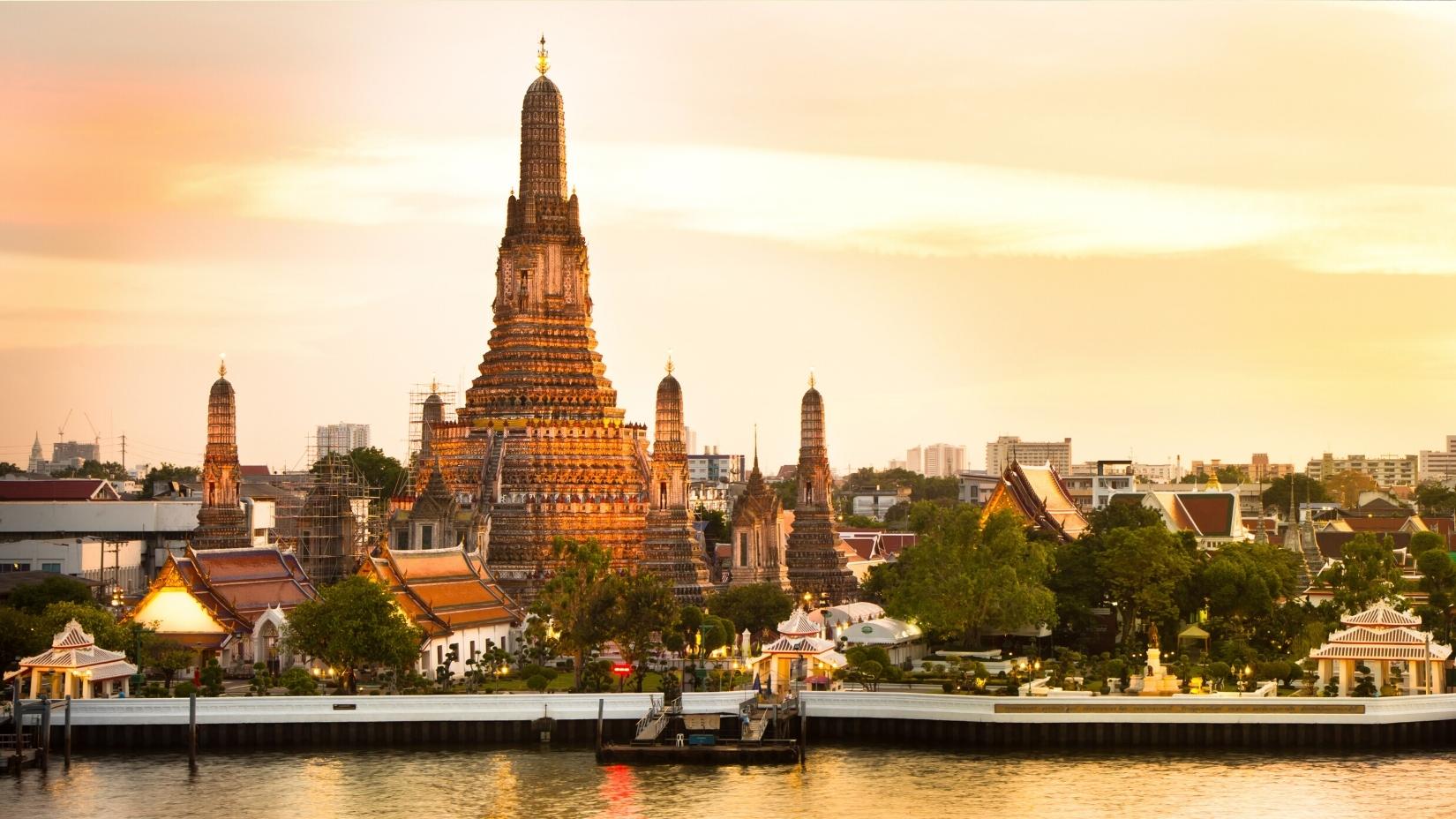
Wat Arun
You need a full-day tour to visit those recommended places. When the night falls, and if you are still full of energy, let's join another adventure: exploring Bangkok at night by tuk-tuk. The best place to have street food at night in Bangkok is Phetchaburi Soi 5. It is full of food carts and is a place where you can eat delicious foods such as coconut pudding and Thai-style grilled meat. From here, you can continue to catch a glimpse of two beautiful Bangkokian landmarks: The Marble Temple and the Anantasamakom Throne Hall.
Day 3: Bangkok Full-Day Floating Market and River Kwai
After a full day in Bangkok with a lot of sightseeing in historical and cultural places, now it is time to explore the neighboring provinces: Ratchaburi & Kanchanaburi. Let's see what they have to offer.
Ratchaburi located 80km west of Bangkok, is a scenic provincial town with a wealth of natural and cultural attractions. The most popular attraction of this province is Damnoen Saduak Floating Market. Kanchanaburi shares the border with Ratchaburi. It is one of the most popular tourist destinations. This is an ideal place to learn about the tragic history of Thailand during World War II by visiting iconic places such as the Death Railway, the Bridge over the River Kwae (Kwai), and the Allied War Cemetery. Below is more detail about the historical and cultural places of these 2 provinces.
Damnoen Saduak Floating Market
It is one of the 5 most popular floating markets in Thailand, a great place for taking photos, enjoying the local food, and learning more about a bygone way of life. It takes about one and a half-hour by car from Bangkok to the market and the best time to visit the market is in the early morning to avoid the heat and crowd, so you should start the trip to the market very early in the morning. It is a tourist trap where you can see hundreds of vendors and purchasers floating in their small rowing boats selling and buying agricultural products and local food. They are always overpriced, so do not forget to bargain.

Boat in Damnoen Saduak Floating Market
The best way to explore the floating market is to hop on a long-tail boat, which is slow but it will take you through a peaceful neighborhood of houses raised on stilts. Do not forget to check out those houses. Arriving at the entrance of the floating market, you need another boat which is a small wooden boat, often sailed by a woman. Being on the paddle boat, you will be able to sail through the small canals, get a chance to interact with local people, buy the local product like food, or hand carvings, candles, and clothes, cheap chopsticks, postcards, gems for a souvenir, and try the delicious Thai food like Thai pancakes, dumplings, famous Pad Thai or fresh fruits.

Vender on Floating Market
Bridge over the River Kwai
Bridge on the River Kwai is a part of the Thai-Burma Railway that has taken away numerous life of Prisoner of War during World War II. The bridge was built within only one month by allied prisoners of war, including British, American, Australian, Dutch, and New Zealand military, together with many Chinese laborers, Yuan, Java, Malay, Thai, Burmese, and India. Due to the cruelty of war and disease including food shortages, a huge number of prisoners of war died. The bridge was then destroyed by bombs in 1944 and rebuilt by the Thai government in 1946 and it is now a symbol of peace. Through a visit to this bridge, you will be able to know more about Thai history.
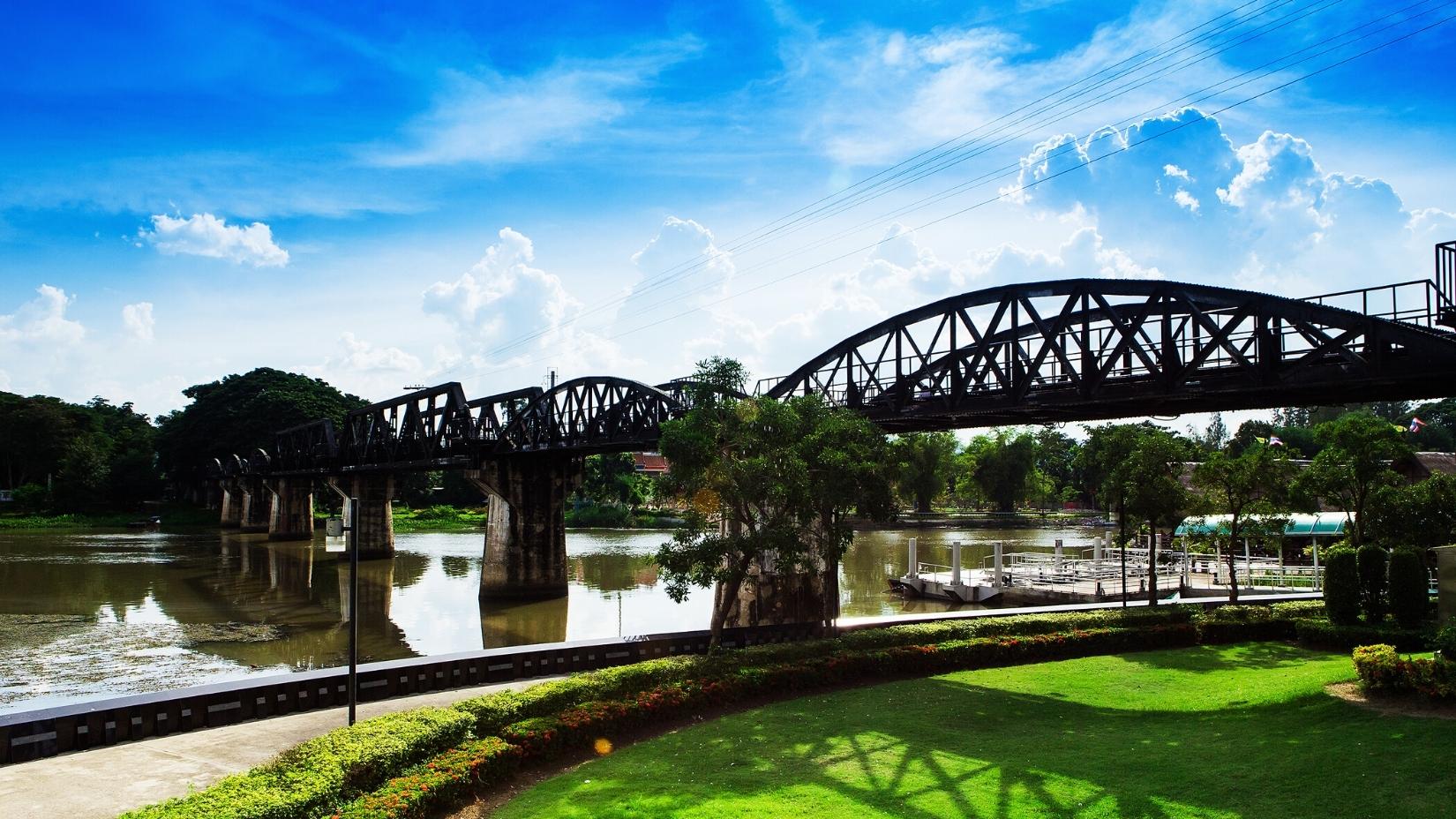
Bridge over River Kwai
Death railway
Death railway or the Thai-Burma Railway was constructed for the Japanese to cross the border with Burma to the northwest during World War 2. It is a 415-kilometer (258 mi) railway between Ban Pong, Thailand, and Thanbyuzayat, Burma. The Thai portion of the railway continues to exist and is a popular destination for tourists who want to learn more about history during World War 2. Rail workers were allied prisoners of war, including British, American, Australian, Dutch, and New Zealand military, approximately 61,700 people, together with many Chinese laborers, Yuan, Java, Malay, Thai, Burmese, and India. Tens of thousands of prisoners of war died when building this railway. About 7,000 POWs are buried at the Kanchanaburi War Cemetery, and around 2,000 in Chung Kai War Cemetery. It is estimated each kilometer of railway track costs at least 38 Allied Prisoners of War death. A scary number, isn't it?
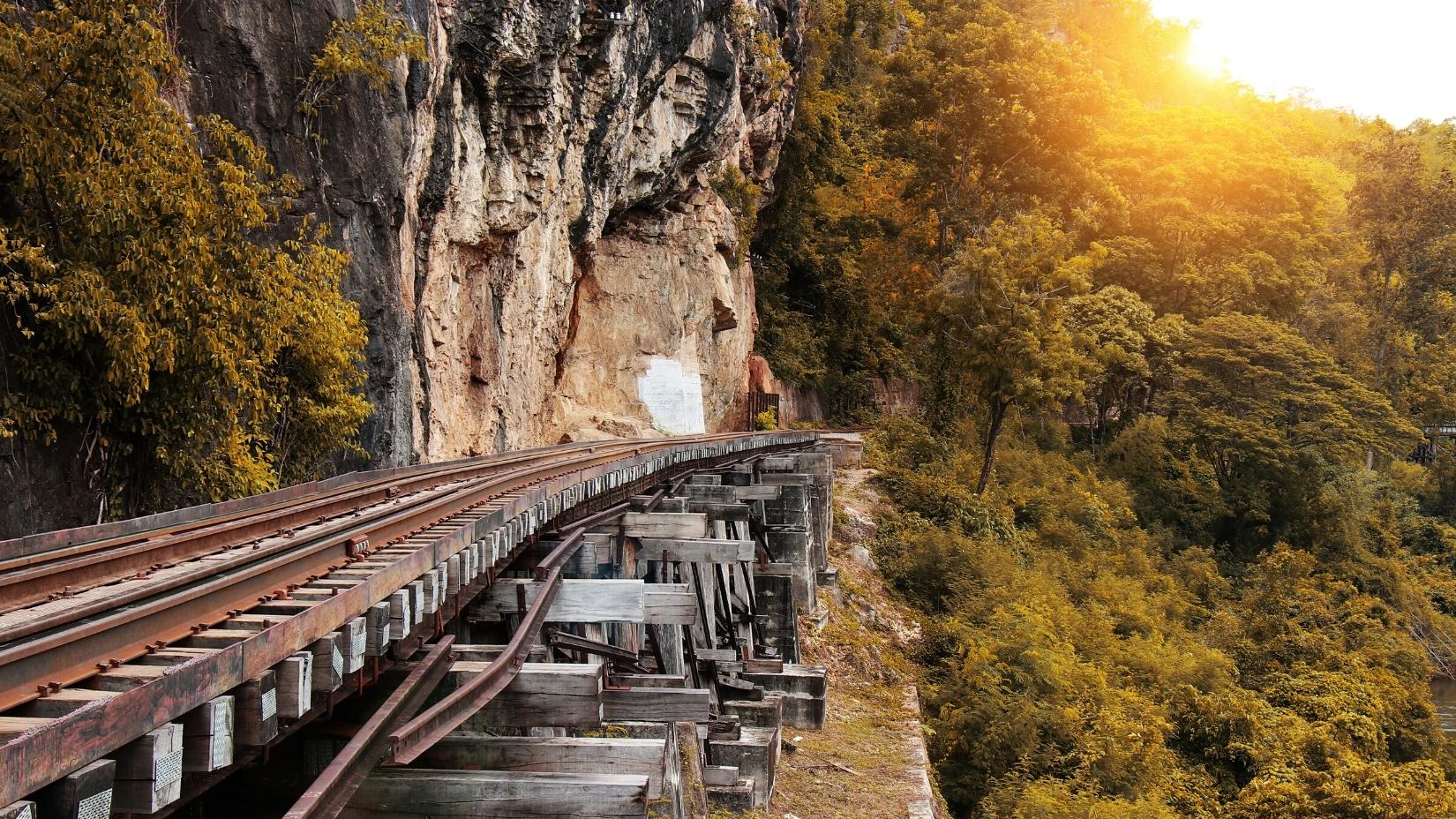
Peaceful Death railway on the sunrise
Kanchanaburi Allied War Cemetery
Kanchanaburi Allied War Cemetery is the final resting place for almost 7,000 casualties of the Second World War, including 5,086 Commonwealth graves and 1,896 Dutch graves. The cemetery lies on the grounds of what was originally the main intake camp for prisoners sent to work on the Thai-Burma Railway. Almost 50% of those are thought to be imprisoned to work on the railway and die throughout the process. At the cemetery, there is 1 special grave. It contains the ashes of 300 prisoners who were cremated at Nieke Camp in 1943 in an attempt to stop the spread of a Cholera outbreak. This cemetery also has the Kanchanaburi Memorial which lists 11 men from the army of the undivided India who was buried in Muslim cemeteries throughout Thailand. With the effort to keep this place with wonderful green lawns and colorful flowers, The Commonwealth War Graves is doing their best to support the cemetery.

Kanchanaburi Allied War Cemetery
After a full-day tour of Ratchaburi & Kanchanaburi, you will be back in Bangkok to stay a night there.
Day 4: Bangkok - Ayutthaya - Lopburi - Phitsanuloke
Continuing our adventure to northern Thailand, we travel from Bangkok to Phitsanuloke with stops at beautiful sightseeing places: Bang Pa-In Royal Palace, Ayutthaya, Phra Prang Sam Yod.
Bang Pa-In Royal Palace
It is also known as the Summer Palace, a palace complex formerly used by the Thai kings. It spreads out over a huge area that is filled mainly with grassy lawns and massive water features. Little canals run through most of the compound, connecting to the river alongside it. The buildings in the palace are interestingly diversified. A Chinese-style royal palace, a colorfully painted lookout tower follows the traditional but simple Thai style of architecture for the smaller residences. You can also find a lot of styles or designs influenced by European or English. Bang Pa-in Palace is very rarely used by the royal family and has been left for the tourists but there are not many of them. That makes this place more tranquil and is a perfect escape from the craziness of busy Bangkok.

Bang Pa In Royal Palace
Ayutthaya
It is the former capital of the Thai Kingdom, with three palaces and more than 400 temples. It was home to over a million people and used to be one of Asia’s major trading ports. In 1767, the Burmese attacked and conquered Ayutthaya, destroying the majority of towers, monasteries, temples, and palaces. However, several structures have been restored and tourists are welcome to visit these wonderful Ayutthaya attractions. Ayutthaya Historical Park comprises four interesting temples: Wat Phra Ram, Wat Phra Si Sanphet, Wat Mahathat, and Wat Ratchaburana. It has been recognized on the list of UNESCO World Heritage Sites and is a good place to visit if you are interested to learn more about Ayutthaya’s heritage.

Ayutthaya
Phra Prang Sam Yod in Lopburi
Phra Prang Sam Yod is one of the oldest but best-known landmarks in Lopburi. It is one of several monuments that date back to the Khmer era. Phra Prang Sam Yod is perhaps best known for the large number of monkeys that run around free, constantly on the lookout for food. The Phra Prang Sam Yot consists of three Khmer-style laterite prangs, the central one being the tallest, and the other two a little smaller. The prangs stand on a low base and are connected by vaulted passageways. The towers are adorned with stuccoed decorations of mythological creatures, of which little remains today. Carved into the colonettes of the Southern door, sitting in a niche is a carving of Rishi, a hermit from Indian and Thai mythology. Two of the prangs contain Buddha images in the Lopburi style.
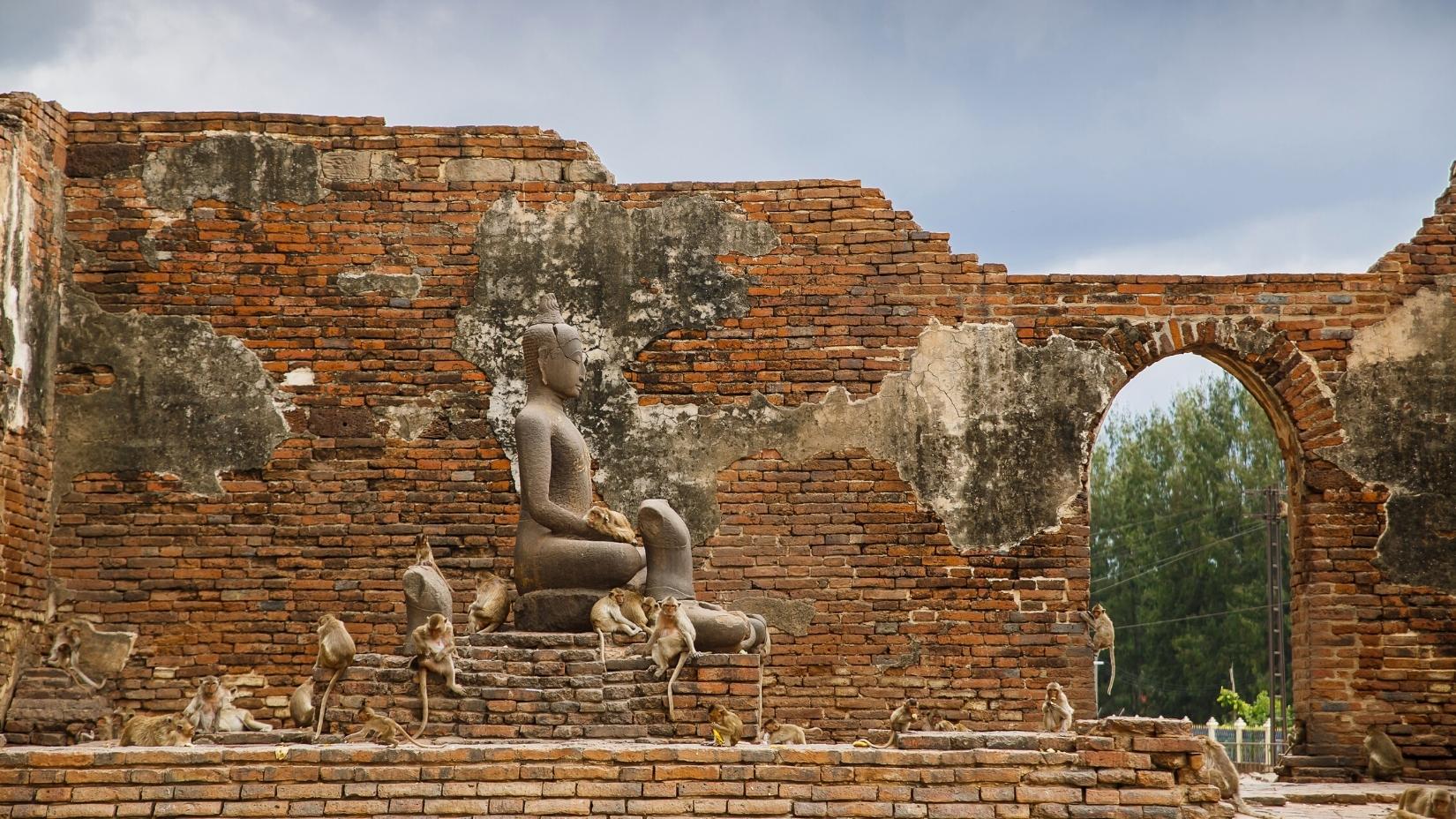
Phra Prang Sam Yod
You then continue to visit the shrine of the Hindu Goddess Kali at the Sarn Prakarn Temple and have an overnight in Phitsanuloke. Phitsanulok is an important, historic city in lower northern Thailand and one of the oldest cities in Thailand, founded over 600 years ago. It is the crossroad between the northern and central regions of the country.
Day 5: Phitsanuloke - Sukhothai - Chiang Rai
Today, you will travel from Phitsanuloke through Sukhothai to Chiang Rai.
Sukhothai
Sukhothai, a historic city in Northern Thailand, was the first capital of Siam founded by King Ramkhamhaeng during the 13th Century. It houses a vast number of historical sites and temple ruins and used to be the cradle of Thai civilization, the birthplace of Thai art, architecture, and language. In Sukhothai, we will visit Wat Sra Sri & Wat Sri Chum.
Sra Sri
Wat Sra Sri is a beautiful wat located on an island surrounded by a pond. Just entering the wat is a beautiful experience as you have to cross a bridge. On the island, you will see a Sri Lankan-style mounded chedi and a walking Buddha in Sukhothai style.
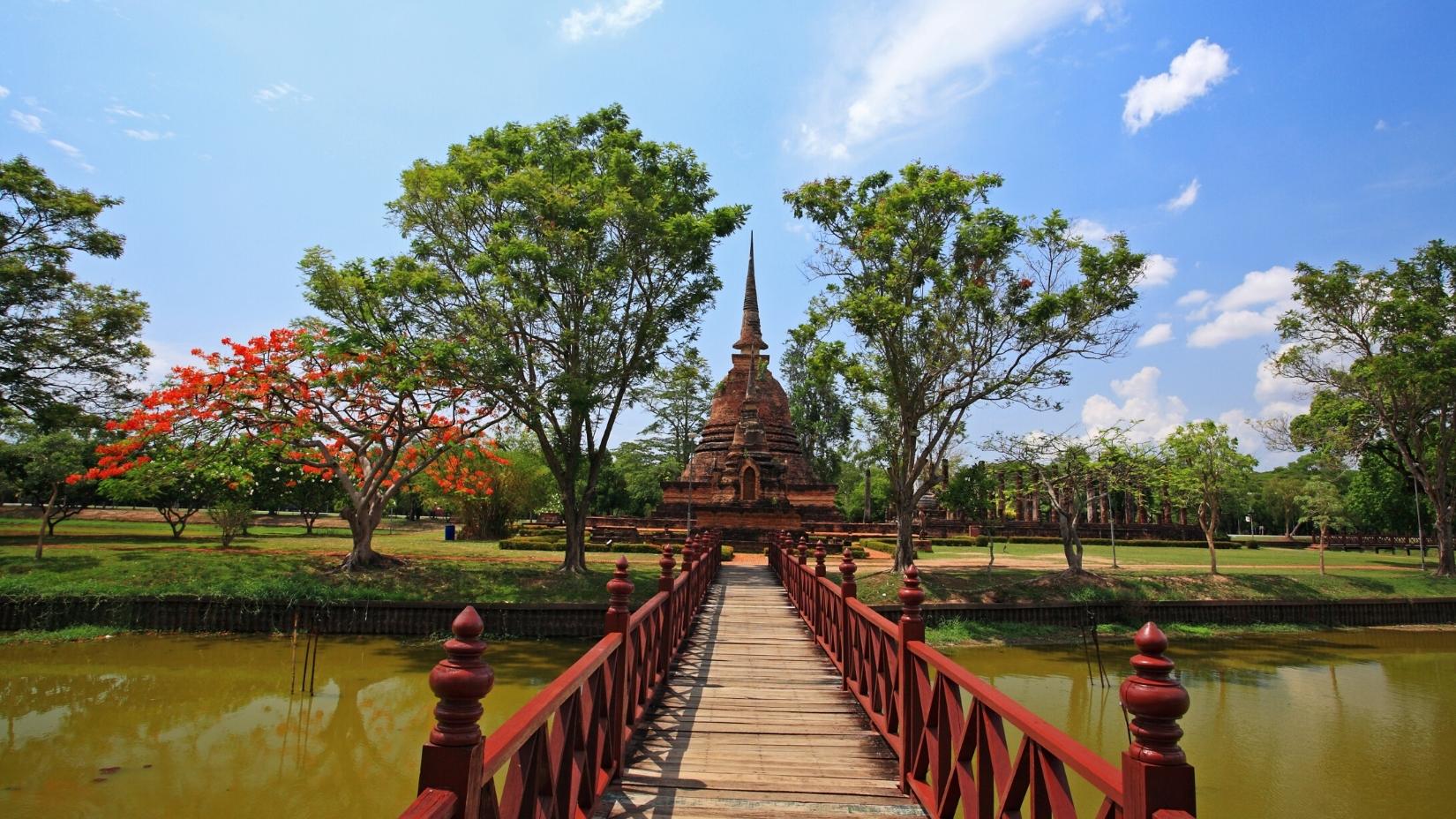
Sra Sri
Sri Chum
Wat Sri Chum is known for its mondo with a large image of the Buddha (called Phra Achana Buddha) partly visible from outside. The Phra Achana is the largest Buddha image in Sukhothai measuring 15 meters high and 11 meters wide.
We arrive in Chiang Rai in the afternoon and have an overnight there.
Day 6: Chiang Rai - Golden Triangle - Chiang Sean
Chiang Rai province is a mountainous region with rivers and jungles, so there is a lot of beautiful nature surrounding the area. The north of Chiang Rai borders Myanmar, the south borders Phayao Province, the east borders Laos, and the west borders Chiang Mai Province. Chiang Rai population consists of people of various ethnic backgrounds, including those from hill tribes and Chinese lineage.
Today, we will visit some of their villages. You will travel on narrow hilly roads through the beautiful landscape with spectacular views of the villages of the Akha and Yao hill tribes.
Then drive to Mae Sai, which is the most northern town of Thailand on the border of Burma for a visit to the famous Golden Triangle. It is the meeting point of the borders of Burma, Laos, and Thailand. For those who would like to come even closer to the border of Burma and Laos, a trip by boat on the Mekong River will be on offer.
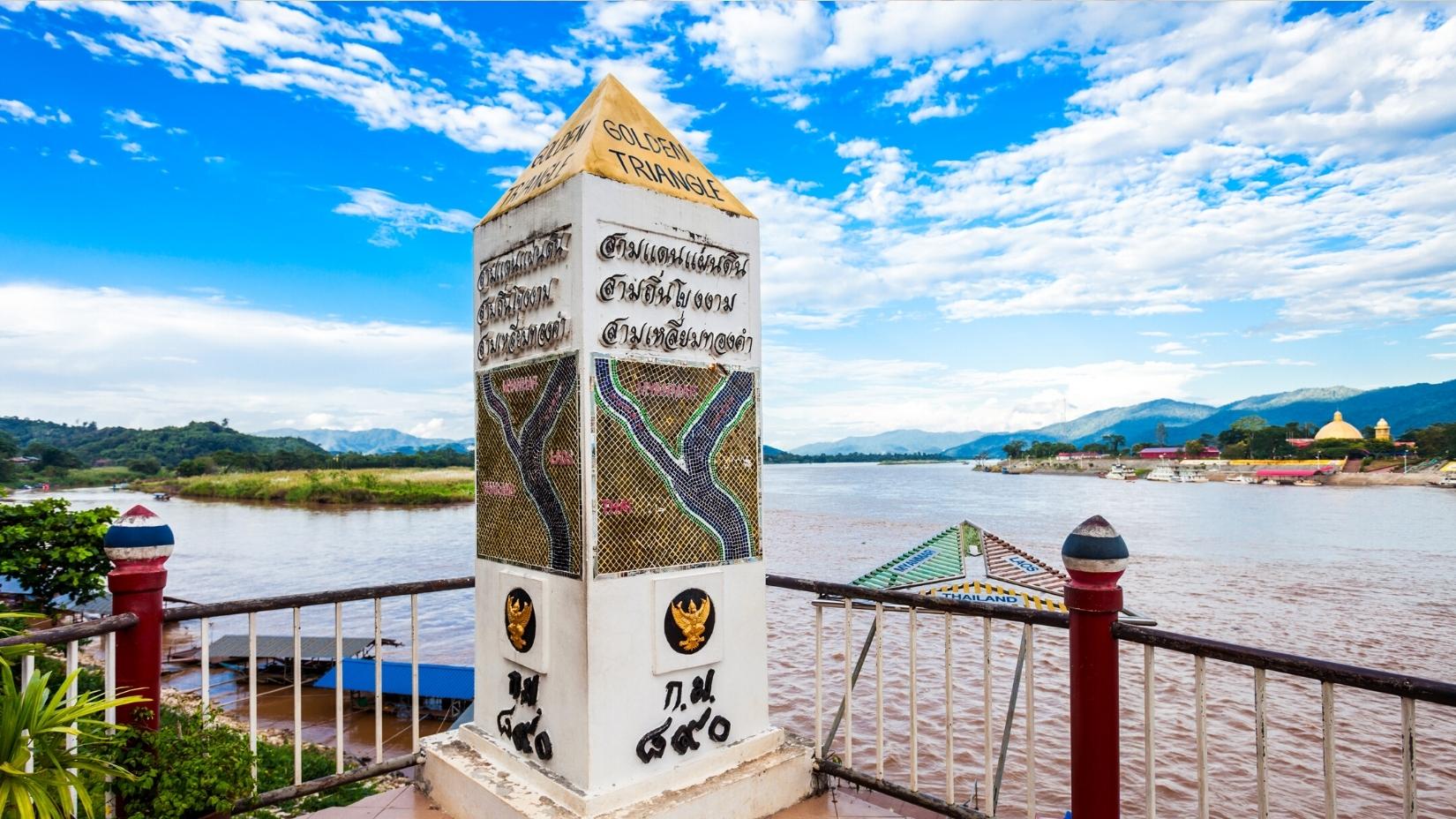
Golden Triangle
We will visit the old Opium House before continuing to the provincial town of Chiang Saen, which is located at the scenic borders of the Mekong River.
Old Opium House
It is a small museum in the Golden Triangle that tells the story of the opium drug trade that gripped Northern Thailand. It is about everything you ever wanted to know about opium but never dared ask. The exhibits display tools and objects used to plant, harvest, and trade opium, including pipes, scales, weights, knives, and scrapers. It also includes some lovely poppy flowers, the source of opium production.
Day 7: Chiang Rai - Chiang Mai
Today, we leave Chiang Rai for Chiang Mai with a few stops at Mae Ka Chan (famous for its hot springs) and Wat Phra That Doi Suthep.
Chiang Mai
Chiang Mai is a land of misty mountains and colorful hill tribes, a paradise for shoppers, and a delight for adventurers. It is also a place to experience Thai massage and join cooking courses. It is a place where the past and the present seamlessly merge with modern buildings standing side by side with venerable temples.

Chiang Mai
Phra That Doi Suthep Temple
Locals say you haven’t truly arrived in Chiang Mai until you’ve been to Doi Suthep Temple. So, do not miss it. From Phra That Doi Suthep Temple, you see all the impressive views of downtown Chiang Mai. There’s the option to hike various trails and swim in waterfalls in the national park that is home to the temple.
After a visit to Phra That Doi Suthep Temple, you will join Traditional Khantoke Dinner and Show in the evening.

Phra That Doi Suthep Temple
Traditional Khantoke Dinner and Show
Traditional Khantoke Dinner and Show offer travelers the opportunity to sample traditional Thai fare in a truly traditional way. The Khantoke Dinner is customary in northern Thai style, and food is served family-style on large platters at low tables while guests relax on floor mats. Entertainment includes performances that highlight the culture and traditions of this rich and diverse country, including dance and music from members of various hill tribes.
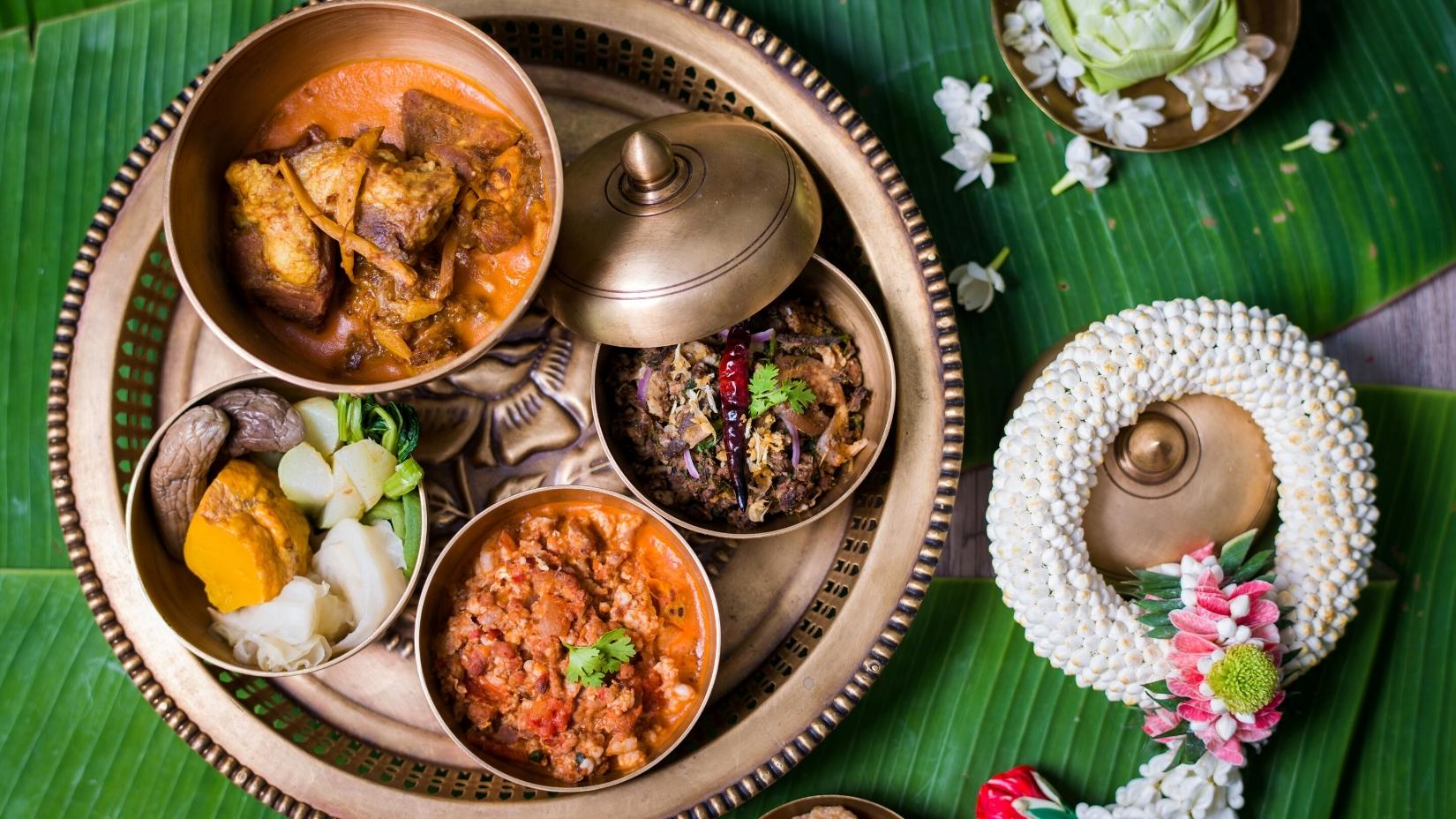
Traditional Khantoke Dinner and Show
Day 8: Chiang Mai - The Elephant - Orchid & Butterfly Farm
Today, we have a full-day tour in Chiang Mai with a visit to Elephant Camp, Orchid & Butterfly Farm, and handicraft villages at San Kampaeng.
Elephant Sanctuaries
There are lots of Elephant Sanctuaries in Chiang Mai which are built to provide a better life for the elephants by providing them a safe, loving, and secure environment for them. Visiting the sanctuary, you will have a chance to see elephants, how they work, and be taken care of. You can also an optional tour to play with the elephant or take care of them.
You may be interested in 5 Elephant Sanctuaries to Visit in Chiang Mai
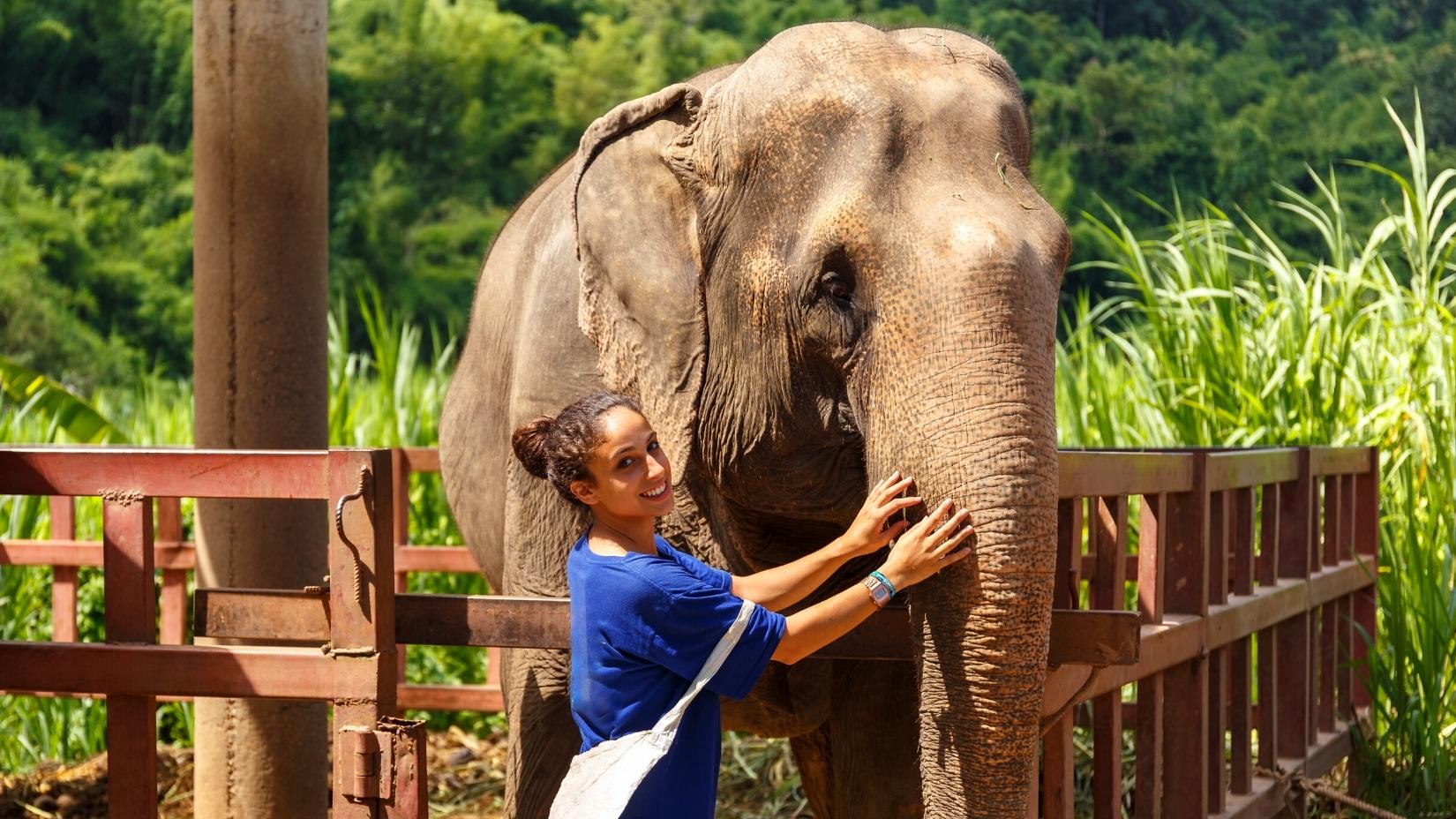
Happy traveler during her visit to Elephant Sanctuaries
Orchid & Butterfly Farm
It is a must-see for orchid enthusiasts and a good place to visit for anyone else. There are two main areas on the farm: the orchids and butterfly breeding enclosure. There is also a gift shop that sells jewelry, including electro-plated butterflies and orchids.
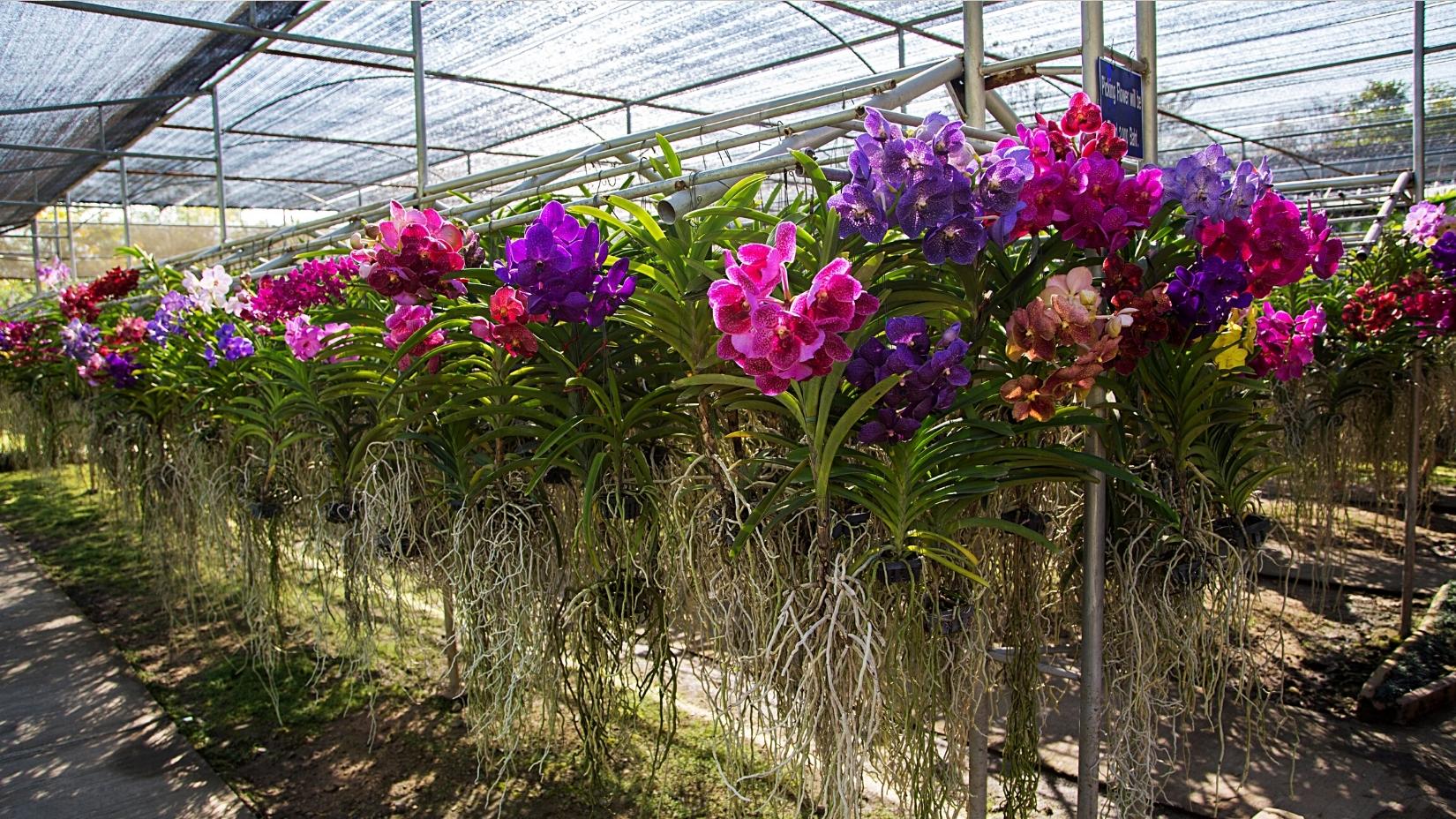
Orchid & Butterfly Farm
Handicraft villages at San Kampaeng
Visiting the villages, you will have a chance to see the artists creating amazing items (including woodcarvings, gems, silverware, Thai silks, lacquer-ware, and making umbrellas), and buy outstanding products that come directly from these manufacturers.
Day 9: Chiang Mai - Bangkok - Fly to Hanoi
Say goodbye to Chiang Mai, we fly to Hanoi.
Hanoi is the capital of thousands of years of civilization, located on the banks of the Red River. It is not only famous for well-preserved colonial buildings, ancient pagodas, and unique museums, but also its delectable cuisine, and vibrant nightlife.
16 days in Vietnam
Day 10: Hanoi City Tour Half Day - Night Train to Lao Cai
In the morning, you can join a half-day city tour with a visit to most of the must-see places: The Temple of Literature, One Pillar Pagoda, Ho Chi Minh Mausoleum, West Lake, and Tran Quoc Buddhist Pagoda.
The Temple of Literature
It is the first university in Vietnam. Founded in 1076, Quoc Tu Giam was established within a temple to educate Vietnam's royalty, mandarins, and members of the elite. It has now become a memorial to education and literature. Every year, thousands of students came to the Temple of Literature, seeking luck before their high school graduation examination.

The Temple Of Literature
Ho Chi Minh Mausoleum
It is the final resting place of Ho Chi Minh, the most iconic and popular leader of Vietnam, known to his people as ‘Uncle Ho’. His body is preserved here in a glass case at the Ho Chi Minh Mausoleum in central Hanoi

Ho Chi Minh Mausoleum
One Pillar Pagoda
One Pillar Pagoda represents a lotus flower growing up out of the water. It is a distinctive and unique architectural structure and historical site. It is considered a symbol of Hanoi city with a thousand years of civilization due to bearing the architectural splendor hallmark of the famous historical dynasty in Vietnam.
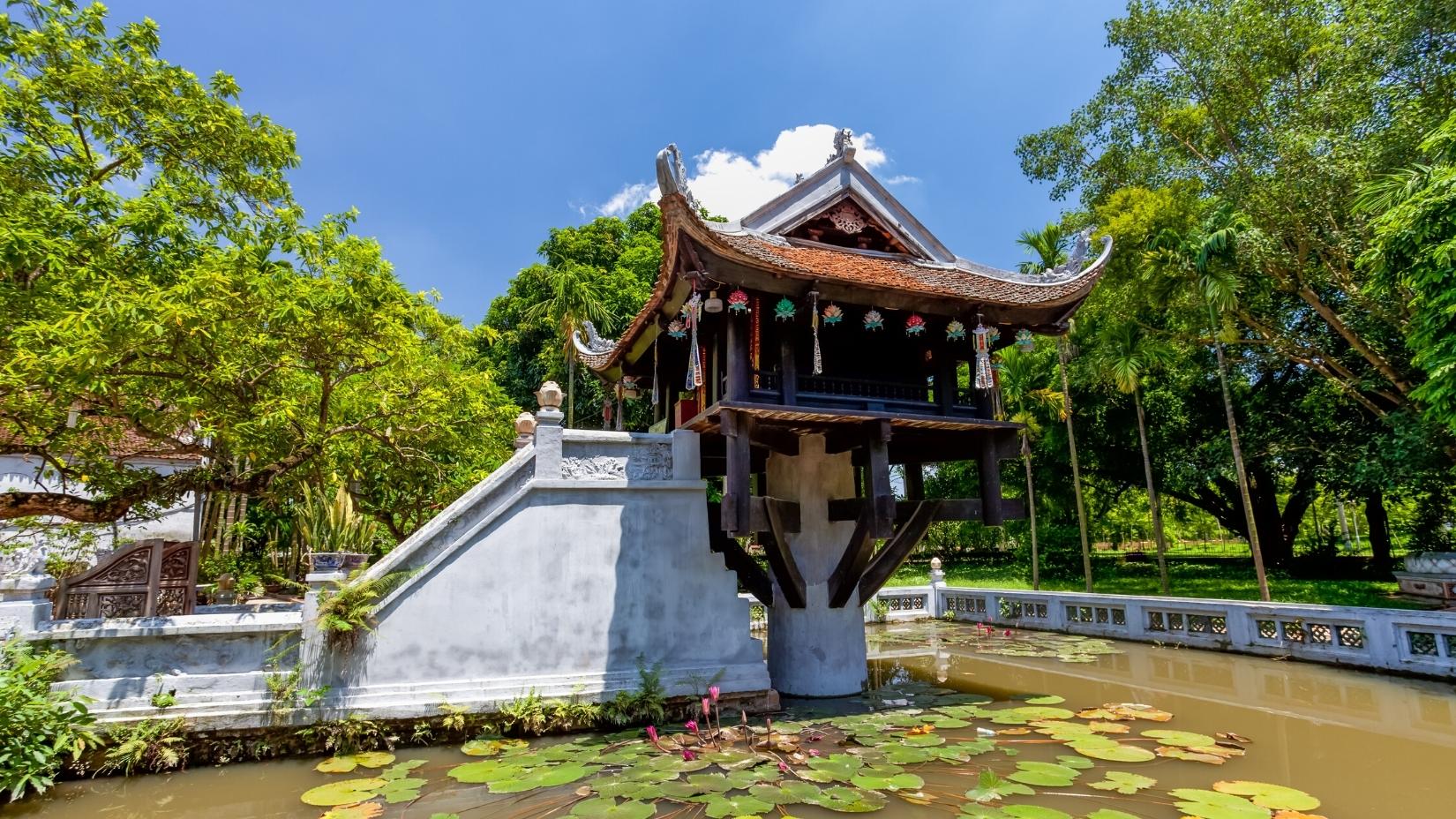
One pillar pagoda
Tran Quoc Buddhist Pagoda
Tran Quoc Pagoda is regarded as the most ancient pagoda in Hanoi with a history line of more than 1,500 years. The temple attracts thousands of visitors from all over the world every year.
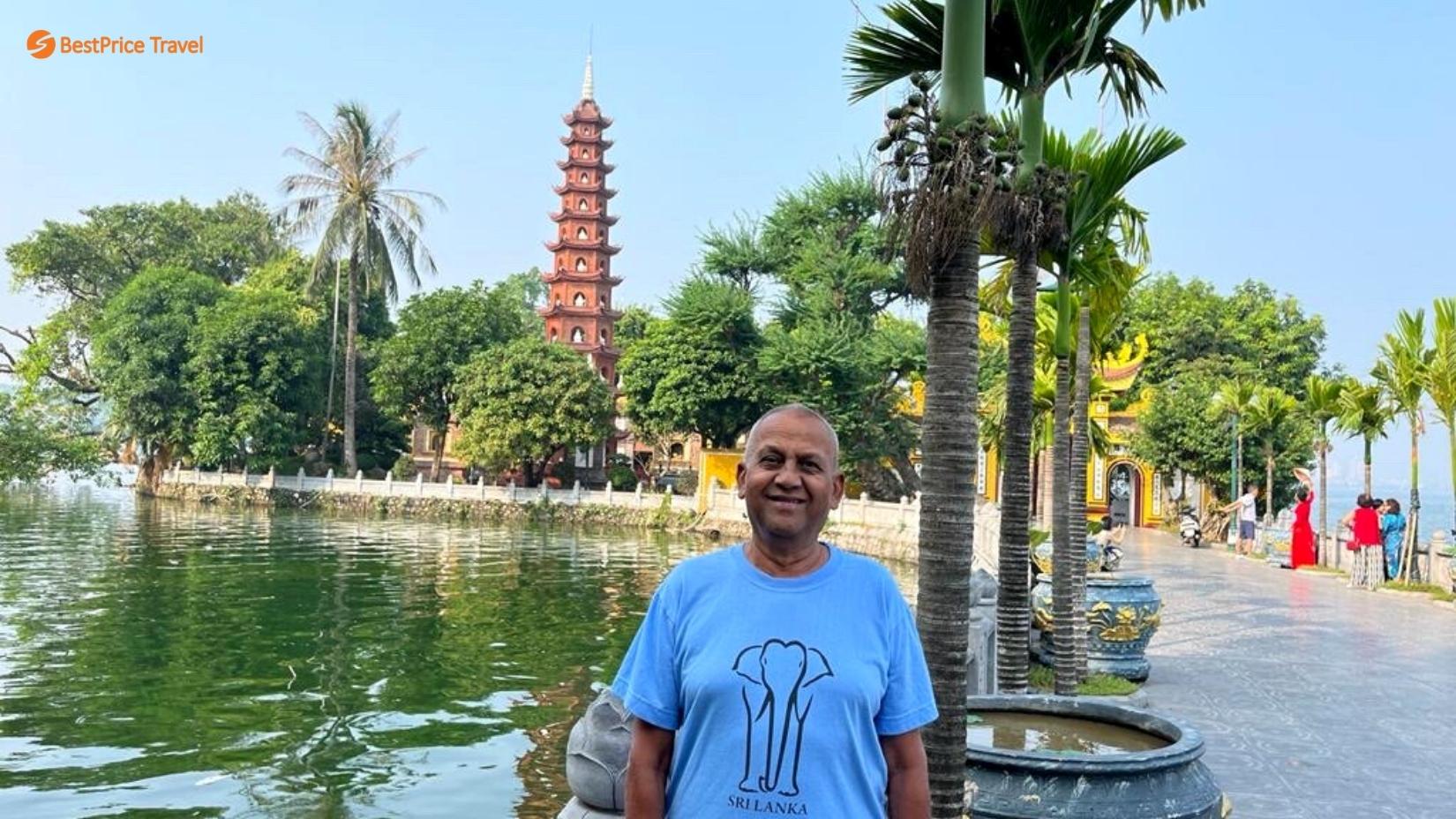
Tran Quoc Buddhist Pagoda
After a half-day tour in the morning, and relaxing in the afternoon, you then take an overnight train to Sapa for a new adventure.
It is highly recommended to join a Hanoi street food tour in the afternoon before the train to Sapa. Joining the tour, you have a chance to taste the best food in Hanoi and interact with local people.
Day 11: Lao Cai - Sapa - Lao Chai - Ta Van
After 9 hours overnight on the train, we arrive at Lao Cai train station. From Lao Cai train station, you can take a 45 mins shuttle bus to Sapa town.
Sapa is well-known for both its fine, rugged scenery and also its rich cultural diversity. Sapa is an incredibly picturesque town that lies in the Hoang Lien Son mountain range near the Chinese border in northwestern Vietnam. Sapa and its surrounding region are hosts to many hill tribes, as well as rice terraces, lush vegetation, and Fansipan, the highest peak in Vietnam. Trekking is the best way to explore Sapa.
Your trekking often starts at 9:00 to two villages of the Hmong and Dzay People, called Lao Chai, and Ta Van. The distance from Lao Chai to Ta Van is about 3km. After trekking in the morning, you will have lunch with local people in the local house architecture, so you will be able to learn more about their daily lifestyles and exclusive custom.
Lao Chai
Located 6 km far from the center of town, it is a village backed by high mountains and facing the river, where Black H’ mong people are living, it is also the beginning of a valley which is called Muong Hoa valley. Here you will enjoy the fresh air, see terrace fields, and streams, visit and discover some of the H’ mong’s families, interact with them, and learn about their culture and customs.
Ta Van
Located 10 kilometers from Sapa center, Ta Van is a peaceful village in the valley of Muong Hoa and it houses the H’Mong ethnic, Giay, and Red Dao… with approximately 1000 people. The road leads to Ta Van village which is small, and narrow, but beautiful with a fertile terraced corn and rice field, and stilted houses. People here not only grow rice but also produce instruments and engraved silver.
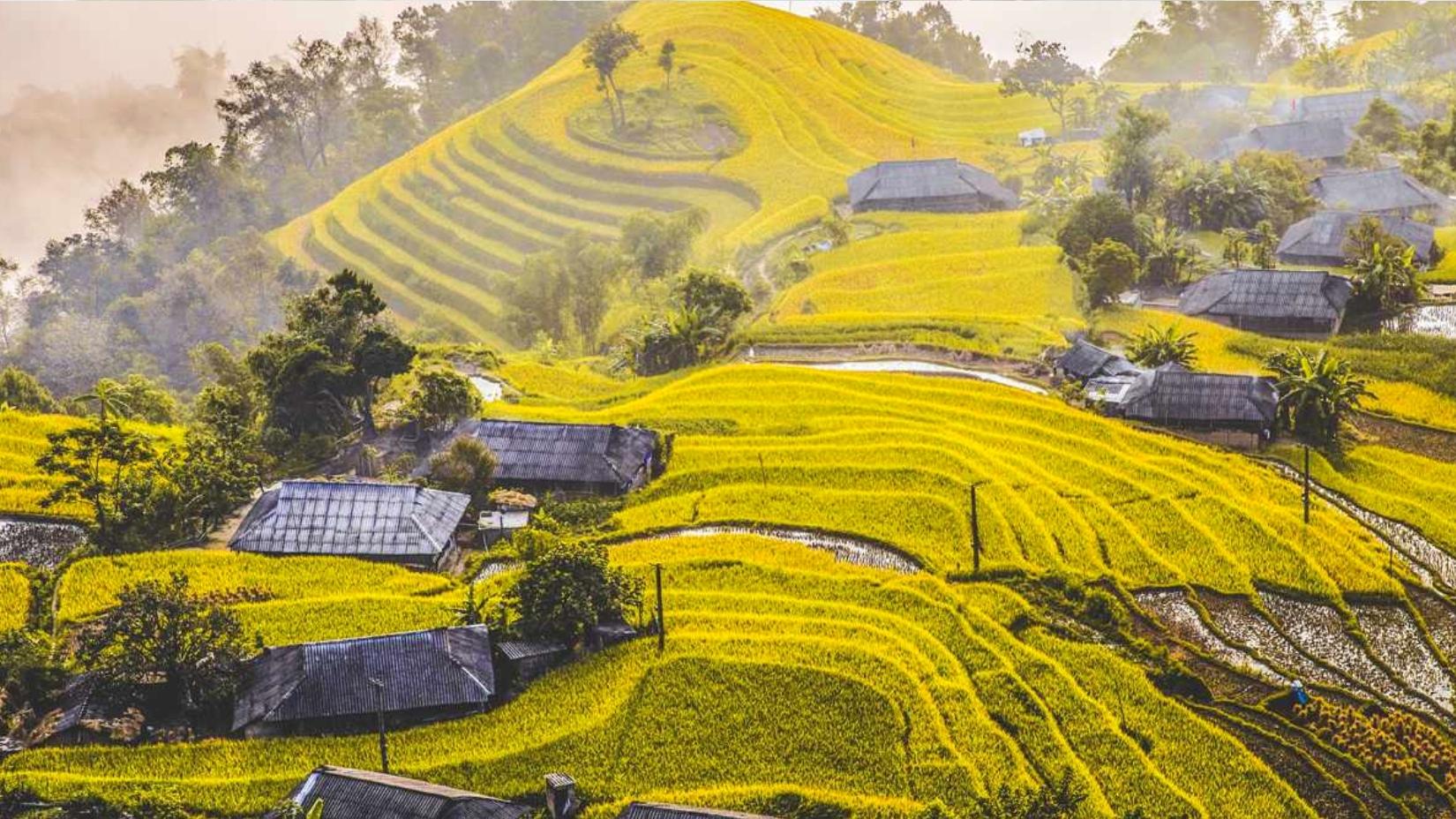
Ta Van
When the trekking ends, there will be a bus to pick up you back to Sapa town or you can trek 2 more km to stay at a homestay.
Day 12: Sapa - Cat Cat - Sin Chai - Hanoi
Today we make our way to the South-west of Sapa and visit Cat Cat Village, one of the more well-known ethnic villages of Sapa. Relax at the foot of the stunning waterfall and the vestige of a hydroelectric power station that was constructed by the French during the colonial time in Vietnam.
Enjoy a picnic lunch by the side of the river, and then continue trekking to Sin Chai Village. Then come back to the main road to be transferred to Sapa town on a jeep for 3km.
Cat Cat Village
Cat Cat is a lovely village with beautiful landscapes like mighty mountains, immense forests, amazing terraced fields, beautiful valleys, and dazzling waterfalls. It is surrounded by rice terraces and rolling green hills. It is considered one of the best places in Sapa for trekking, witnessing the picturesque scenes of Sapa, and experiencing the way of life in the mountainous area.
Sin Chai Village
Located at the foot of Fansipan Mountain, “the Roof of Indochina”, Sin Chai Village is the place where you enjoy the stunning landscapes of the mountain. It is one of the best view spots in Sapa, and home of about 1.400 Mong people
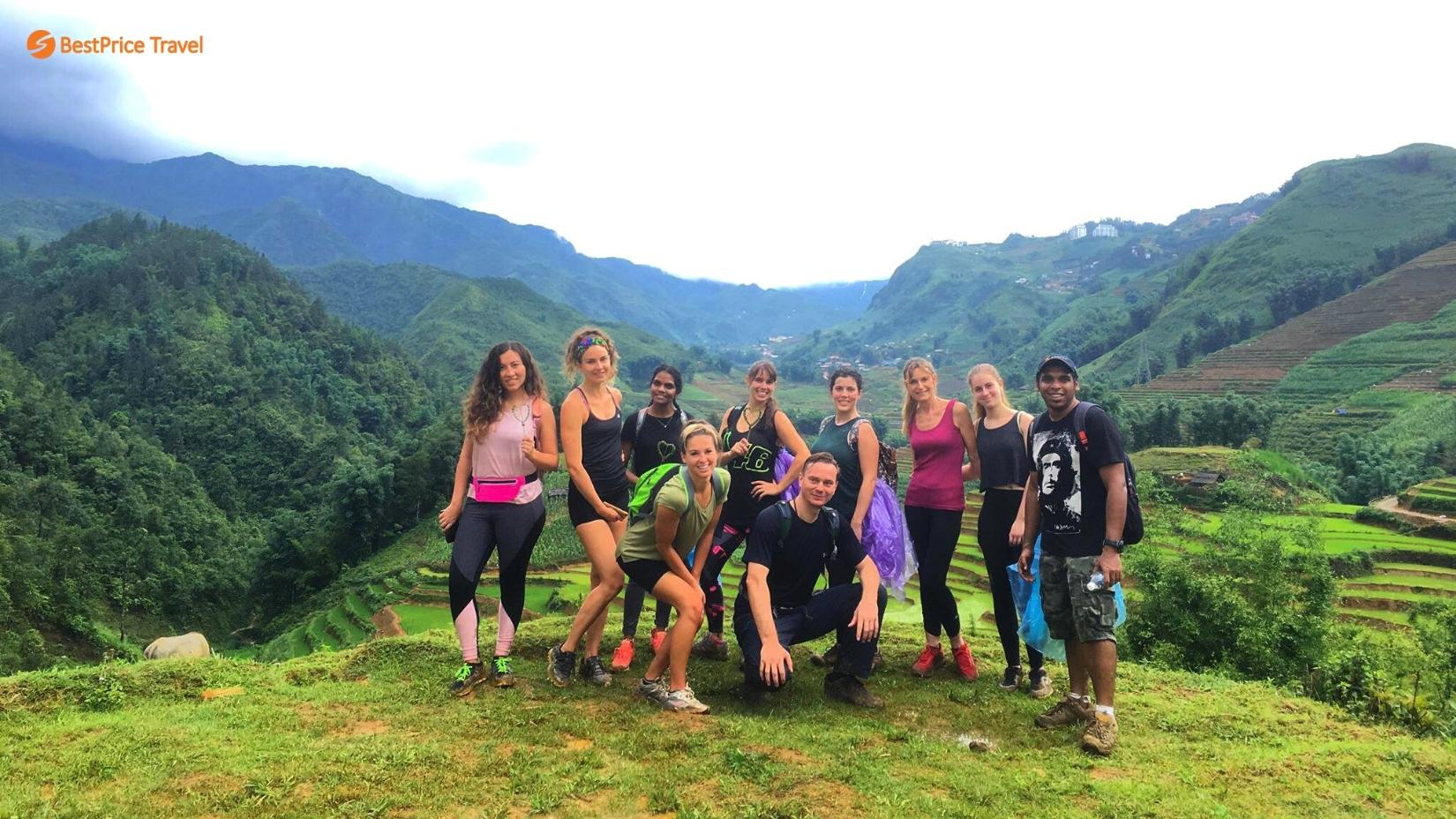
Sin Chai Village
In the afternoon, take a 6 hours bus to Hanoi.
Day 13: Hanoi - Hoa Lu & Tam Coc (Ninh Binh) - Hanoi
From Hanoi, we can take a day tour to Ninh Binh and visit many historical sites and beautiful landscapes Hoa Lu, Tam Coc, and Bich Dong.
Ninh Binh
It is about 93 km south of Hanoi and possesses limestone karsts, temples, and pagodas, rice paddies. It also has a rich diversified tourist potential with a lot of world heritage sites. It is a popular destination for both local as well as international travelers.
Hoa Lu
It is the ancient capital of Vietnam during the Dinh and Le dynasties. In Hoa Lu, there are temples dedicated to Emperor Dinh Tien Hoang of the Dinh Dynasty (968-80) and Emperor Le Dai Hanh of the Le Dynasty (980-1009). In Hoa Lu, there are lots of limestone karst hills; climbing uphill, you will be able to see spectacular views of Hoa Lu.
Tam Coc
It is also called the ‘Halong Bay on Land,’ this region is famous for its charming grottoes and limestone karst mountains. There, you will take a sampan trip down the Tam Coc River rough mountain cliffs, discover mysterious caves, and observe the golden rice fields.
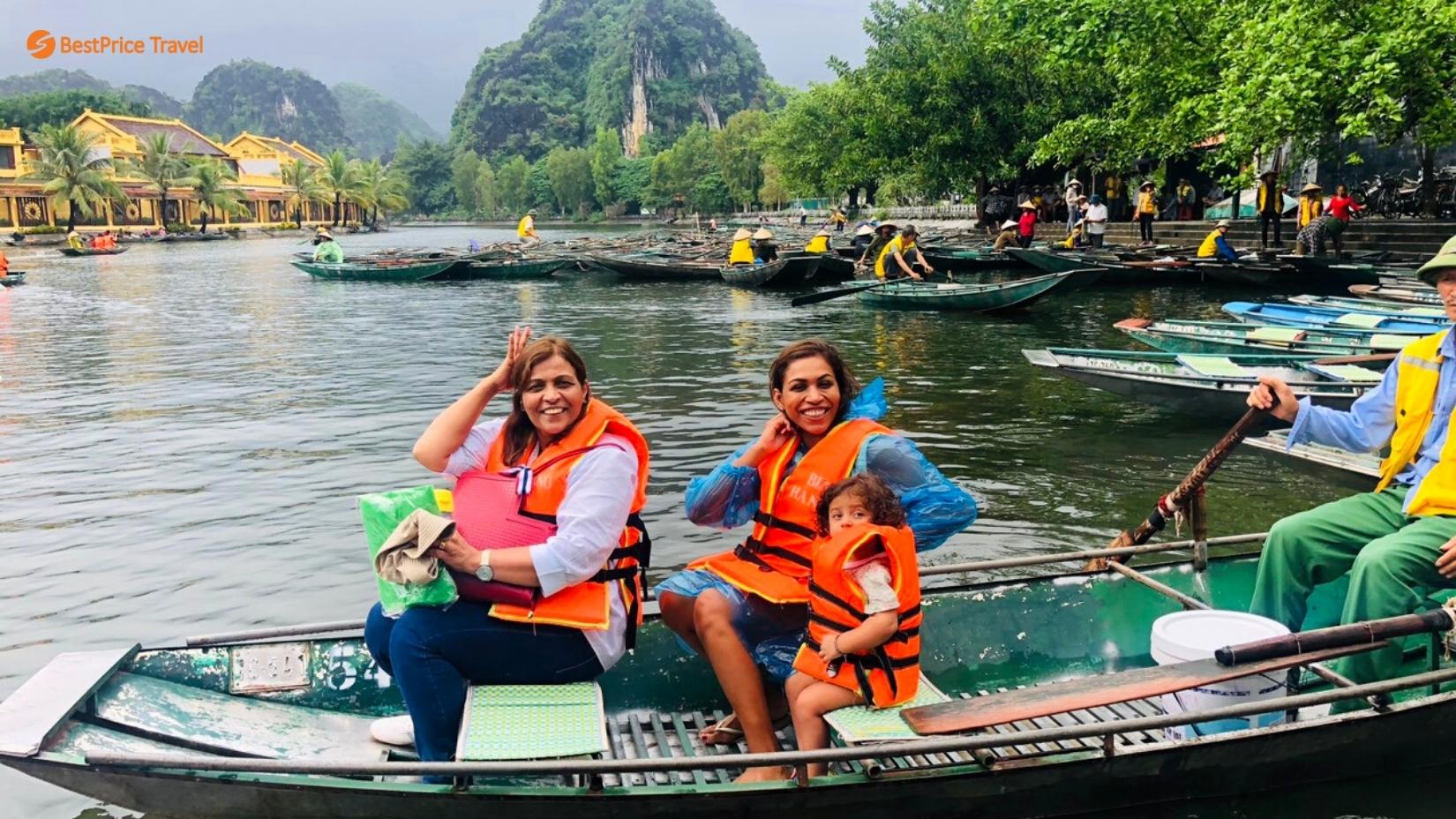
Tam Coc
Bich Dong Pagoda
For those feeling adventurous, climb up to the 15th-century Bich Dong Pagoda on nearby Ngu Nhac Mountain. Bich Dong Pagoda includes 3 separate pagodas: A bottom pagoda, a Middle pagoda, and a Top pagoda, leaning on the mountain from the bottom to the top. Bich Dong pagoda is famous for not only its beautiful and charming scenery but also for being a place of historical relics of Ninh Binh province.
After visiting those places, you get transferred to Hanoi in 3 hour car.
You may be interested in 5 Best Specialties to Try in Ninh Binh
Day 14: Hanoi - Halong Bay - Overnight on Cruise
The next destination for your trip to Halong Bay. After about a 4-hour transfer, you will reach Halong Bay. Halong Bay is listed as a World Heritage of outstanding natural beauty, known in Vietnamese as “Dragon descending to the sea”.
Upon arrival, the boat crew welcomes you and check-in then enjoy a cruise around Halong Bay with a delicious local seafood lunch served on board. You can also behold thousands of limestone islands and grottoes rising from the clear, emerald water.
Following the break, depending on each cruise’s itinerary of the day, you’ll join some activities on the boat to discover the beauty of the bay such as visiting a cave, kayaking, or swimming in the sea before getting back to the junk for relaxing and dining. Overnight on board.
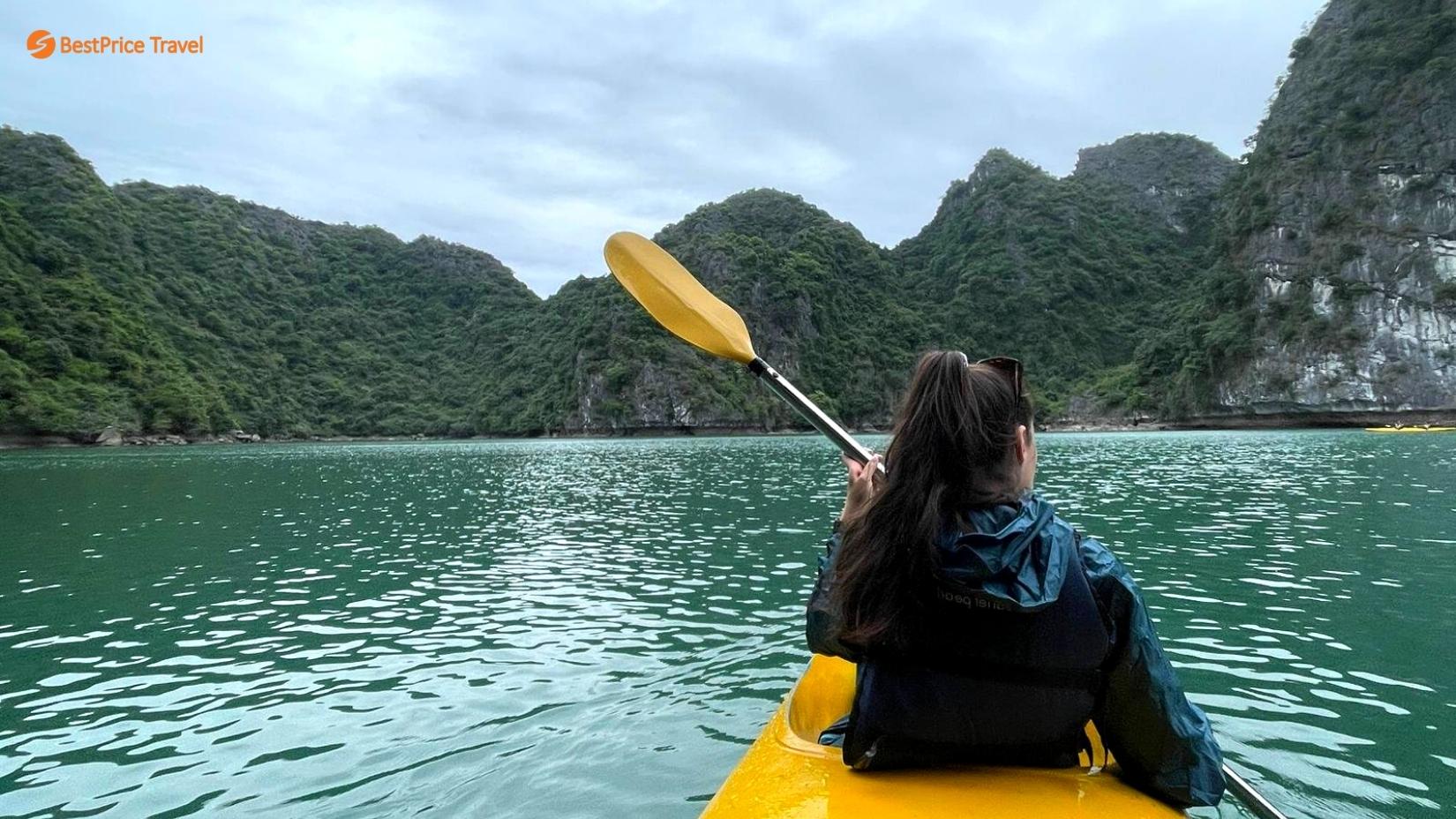
Kayaking in Halong Bay
Day 15: Halong Bay - Hanoi - Fly to Hue
Early risers can enjoy a memorable sunrise over the karst formations of Halong Bay. Breakfast will be served shortly thereafter. Enjoy breakfast (brunch on some boats) while the vessel cruises slowly through the magnificent rock formations back toward the port.
You will either come back to Hanoi or travel to the airport in Hai Phong for the 1 hour and 20 mins flight to Hue.
Day 16: Hue Half-Day City Tour
Hue
Hue, located on the bank of the Huong River, was recognized by UNESCO as one of the World Heritage Sites. It is home to national treasures, temples, pagodas, tombs, and monuments. This city is also the cradle of Vietnamese culture and used to be the national capital, educational, cultural, and political center of Vietnam. Thien Mu Pagoda, Imperial Citadel, and Dong Ba Market in Hue are among the top destinations in Hue.
Thien Mu Pagoda
Thien Mu Pagoda is a famous Buddhism attraction which is located at the bank of the enchanting Perfume River. The pagoda is fascinating because of not only the ancient design of the buildings but also the good location at which you could enjoy the peaceful atmosphere of the Perfume River.
Imperial Citadel
Imperial Citadel is the most famous tourist attraction of Thua Thien Hue province. It used to be the place where the King and his family lived and worked. A visit to Imperial Citadel will help us to know more about the luxurious and prosperous lives of the royal family, and learn more about Vietnam's pre-modern history. Some buildings were damaged or destructed during some wars, but the Hue government keeps remaining and conserved this place. Front Gate, the Flag Tower, The King’s Palace, and the Museums of Royal Antiquities in the Imperial Citadel are most visited by tourists.
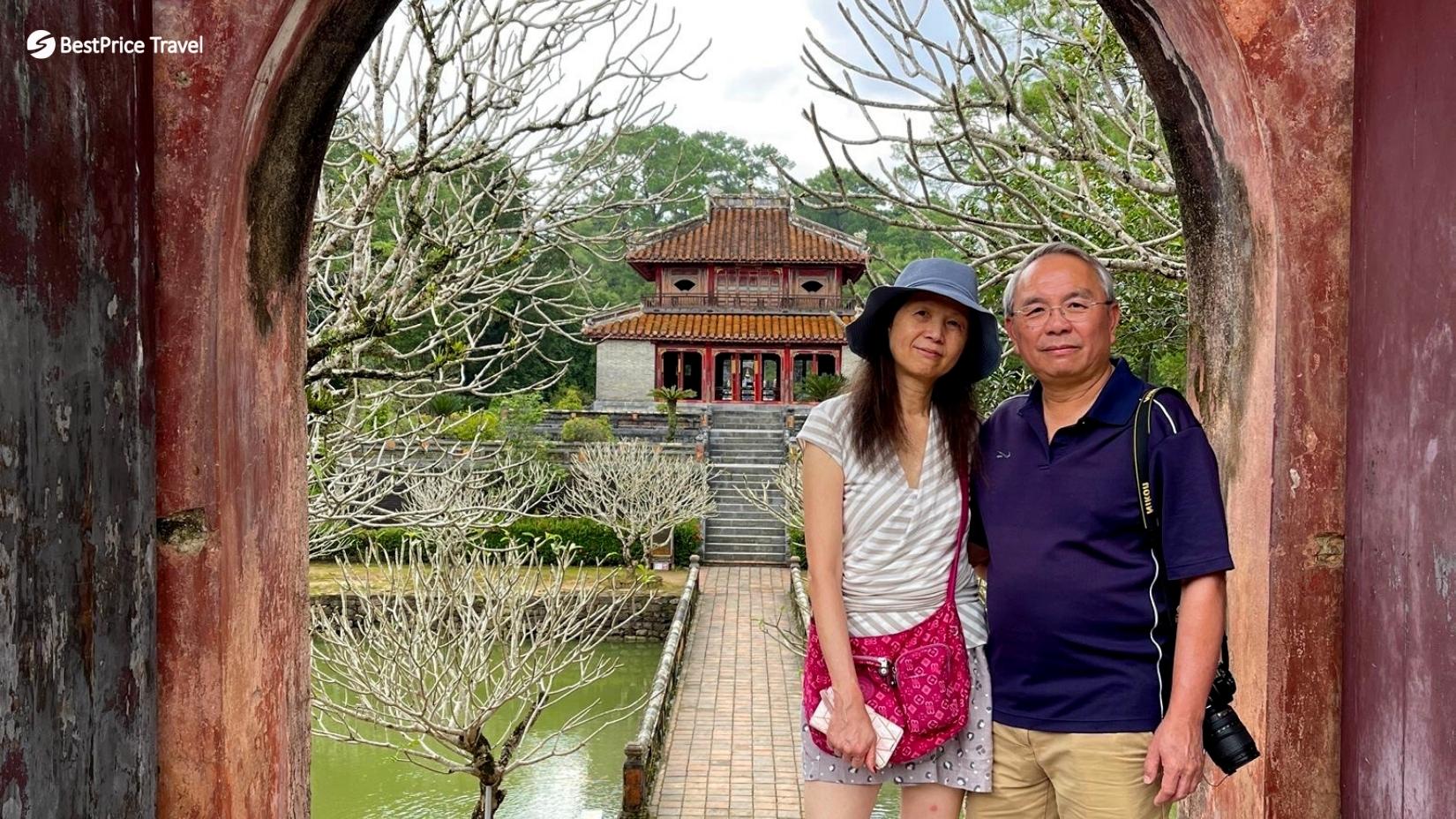
Hue Imperial Citadel
Dong Ba market
Dong Ba market is the largest traditional trading place in Hue City, with hundreds of stalls selling household items, handicrafts, clothing, and fresh produce. Walking through kiosks, you will have a chance to understand the daily business of local sellers, and their way of doing business, as well as purchase some interesting souvenirs before we drive you back to your hotel.
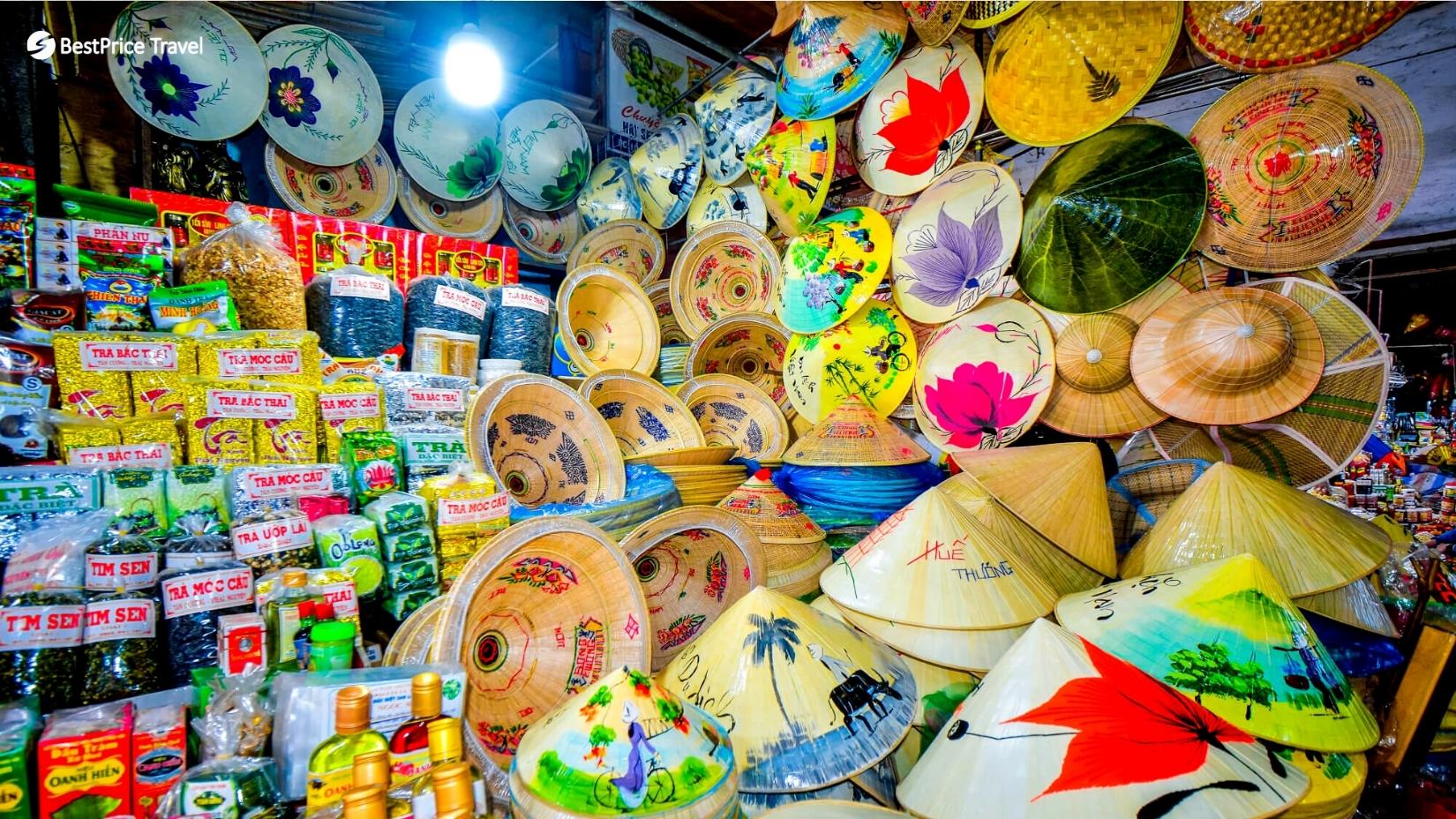
Dong Ba market
Day 17: Hue - Da Nang - Hoi An - Road transfer
Traveling from Hue to Hoi An via Hai Van Pass is a great experience. At 500 meters above sea level with a length of 20 kilometers, Hai Van pass offers an impressive landscape of verdant mountains and clear blue skies, overlooking Da Nang City, Tien Sa Port, Son Tra Peninsula, and the South China Sea. There are a few stops on the roads where you can take photos or go sightseeing.
Day 18: Hoi An Half-day City Tour
Hoi An is an old port town, one of the most famous tourist destinations in Central Vietnam that attract not only domestic tourists but also tourists from all over the world. Tourists have been attracted to architecture which is a mixture of different architecture from Vietnam to Japan, China, and Europe. You can find the unique architecture of Hoi An in many pagodas, temples, and ancient houses like the Japanese Covered Bridge, Phuc Kien Assembly Hall, Ong pagoda, Tan Ky old house, Phung Hung ancient house…Hoi An is also well-known for its cuisine and tailoring. Hoi An is always among the top attractive destinations for foodies all over the world with its specialty like Cao Lau, Mi Quang, Banh Xeo, etc. Moreover, it fabric paradise. There are more than 400 tailor shops in Hoi An where you can easily have your clothes made with different designs and at the best price.
Best way to explore Hoi An town is just walking. We will wander along old streets, cross several old houses; see how the daily lives of local people are, and witness how historical elements of the town merge with modernity, visit some of the ancient monuments from other nations, like the Japanese Covered Bridge or Fujian Assembly Hall of Chinese. You can visit some handicraft store or tailor shop to make clothes or buy souvenirs for your beloved at home.
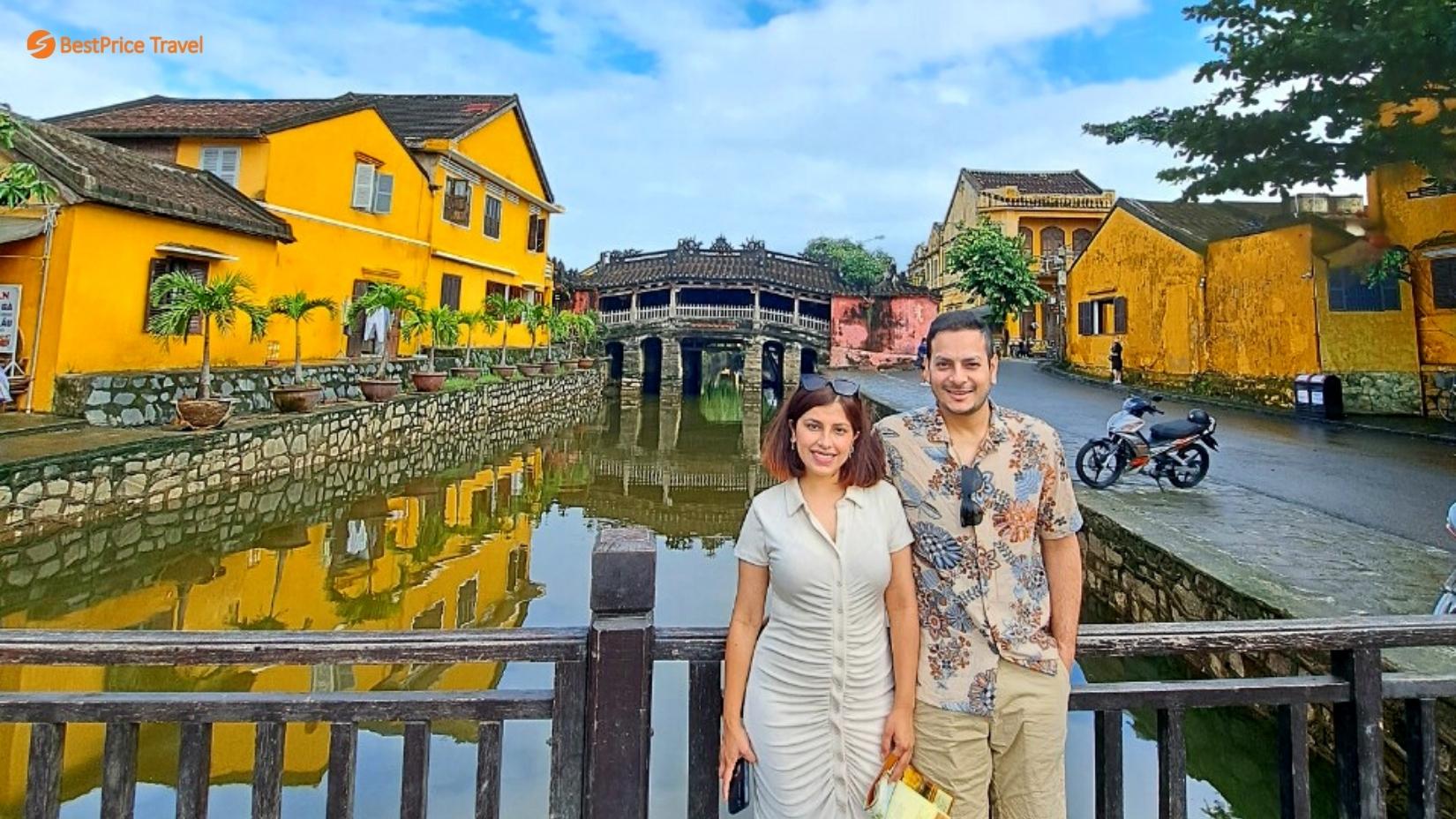
Hoi An ancient town
Do not miss tasting Hoi An cuisine. You can join our tour: Hoi An Motorbike Street Food Tour Half Day to test the best Hoi An food.
Day 19: Da Nang - Train to Nha Trang
Say goodbye to Hoi An, we then head to Danang to take an 8.5 hours train to Nha Trang.
Nha Trang
Nha Trang is a seaside town, also the capital city of Khánh Hòa Province on the South Central Coast of Vietnam. Nha Trang is becoming increasingly popular in recent years thanks to its pristine beach, the best scuba diving center in Vietnam as well as lots of interesting places and delicious food to enjoy. According to historical records, Nha Trang was known as Kauthara under the Champa, as it is still home to the famous Po Nagar Tower built by the Champa. Until the French colonization, Nha Trang used to be no more than a small fishing village. The French recognized Nha Trang as a perfect place for bathing, so they invested in the transformation to turn Nha Trang into a resort town.
Day 20 - 21: Nha Trang Free Days
Free day in Nha Trang, there are a lot of activities for you to choose from. You can visit the Tri Nguyen aquarium, snorkel on Hon Mun island, or visit Hon Tre island.
Tri Nguyen Aquarium
Tri Nguyen Aquarium is situated on Bong Nguyen Island, half an hour from Cau Da Port, Nha Trang City. It is shaped like a boat Seen from afar, Tri Nguyen Aquarium in Nha Trang looks like a fossil ship with a height of 30m, a length of 60m, and a width of 30m. There is a fish pond on the ground floor, souvenir shops on the second floor, and a restaurant on the third one. On its deck is a mast and a cannon, an ideal position to enjoy the fine view of the sea from high above. The aquarium is designed with thick glasses for the sharks, groupers, snappers, and eels swimming around tourists. Walking through space arranged in thick glass layers, tourists will feel like the mermaid in the ocean.
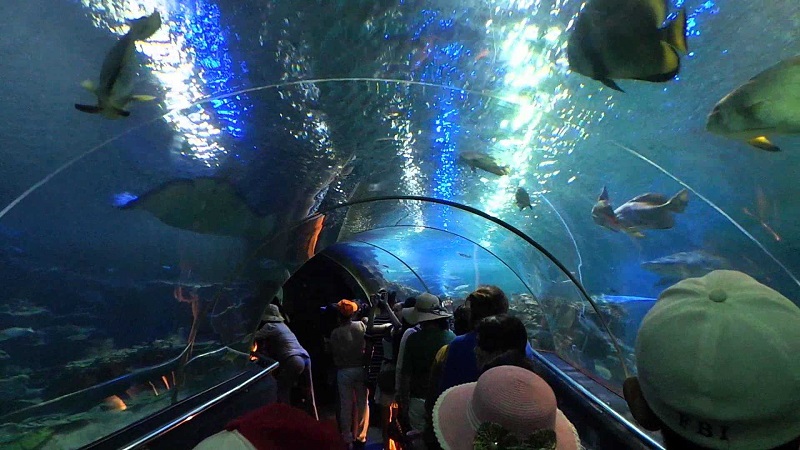
Tri Nguyen Aquarium
Hon Mun Island
Located about 10km from Cau Da port, Hon Mun is not only a romantic island for couples but also an ideal place for people who are interested in various and rich marine creatures, sightseeing, or looking for activities like snorkeling and scuba diving.
The island is beautiful with amazing scenery of the fresh clear blue ocean and full of tropical fish, sea turtles, crabs, and even lobsters. The water is clear and warm; the coral reefs underneath are colorful and the seafood is incredibly delicious.
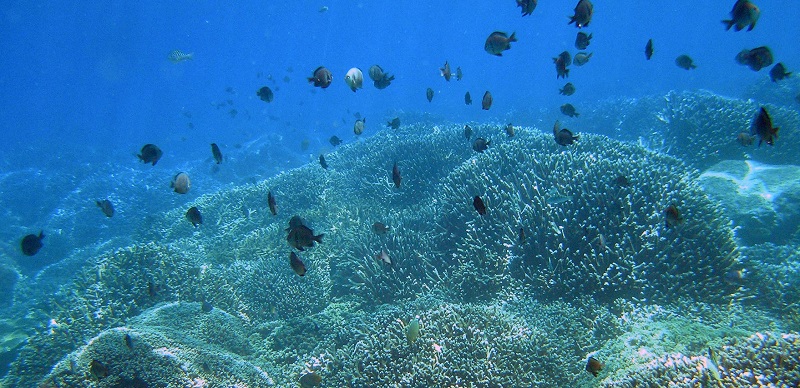
Hon Mun island
Hon Tre island
Located about 3.5km from harbor Cau Da, Hon Tre (Bamboo) Island is the largest island in the Nha Trang complex. People come here to enjoy natural beauty, see the everyday life of local people, and visit wonderful landscapes. The beach on Hon Tre island is beautiful with a clear blue sea, cool water, and calm waves. Local people are friendly and always welcome visitors coming here, especially at some special festivals.
Day 22: Nha Trang - Overnight Train to Ho Chi Minh
In the late afternoon or evening, guide with vehicle pick up at the hotel, then transfer to the train station. Take an overnight train to Ho Chi Minh city.
Day 23: Ho Chi Minh City Half-day City Tour
The train often arrives in Ho Chi Minh city in the morning and we would recommend a half-day tour to explore Ho Chi Minh city. During the tour, you have a chance to visit War Remnants Museum, Saigon Notre Dame Cathedral, the Reunification Palace, Old Post Office, and Ben Thanh market.
War Remnants Museum
War Remnants Museum researches, collects, preserves, and displays documents, photos, and artifacts revealing the crimes committed during the wars of aggression against Vietnam and their consequences. It aims to educate the public, especially young generations, about the spirit of struggle for national independence, the sense of opposition to the wars of aggression, and safeguarding peace and solidarity between nations. The Museum has more than 20,000 documents, artifacts, films, and photos, 1,500 of which are showcased in eight permanent exhibitions.

War Remnants Museum
Old Post Office
This is one of the oldest buildings and a significant symbol of the city. Tourists usually visit here to admire the unique architecture of the post office and feel comfortable relaxing on benches polished with varnish or taking nice photos in such an attractive French-styled building.
Saigon Notre Dame Cathedral
Notre Dame Cathedral is a symbol and one of the most famous Saigon attractions in the financial hub of Vietnam. As one of the most famous attractions in Ho Chi Minh City, this long-age cathedral attracts not only Catholic believers but also tourists and locals of other religions because of its sacred atmosphere and magnificent structure beauty.

Saigon Notre Dame Cathedral
Reunification Palace
The Reunification Palace, also known as Independence Palace, is listed as a historical monument, a must-see place for people who want to learn more about history. Throughout history, this amazing work of architecture had witnessed almost every high and low of the Vietnamese war.
Ben Thanh Market
Ben Thanh market is a big market in Ho Chi Minh City that serves not only the locals for fruits, vegetables, and dry goods but also the many welcome visitors to discover local life and culture. Inside Chợ Bến Thành are many souvenirs, T-Shirts, and other garments as well as traditional handicrafts including lacquerware and embroidery. Different textiles are infamous for Vietnamese and Asian styles as well as western styles. Fabric is also available to buy by the meter to take home.
Day 24: Ho Chi Minh City - Cai Be - Can Tho
Today, we will visit the Cai Be market in Can Tho Province. It is an escape from the city to an incredibly fertile region, the Mekong Delta.
The Mekong Delta
The Mekong Delta is a vast region, comprising 12 provinces in Vietnam. It provides more than half of Vietnam’s rice and fish. Local life for villages in the area revolves around the rivers and canals that make up the delta, so much so that people are more likely to transport by river than road.
Visiting this region, you can enjoy the fresh air and immerse yourself in the tranquility of the countryside, or explore fish farms and exotic fruit farms.
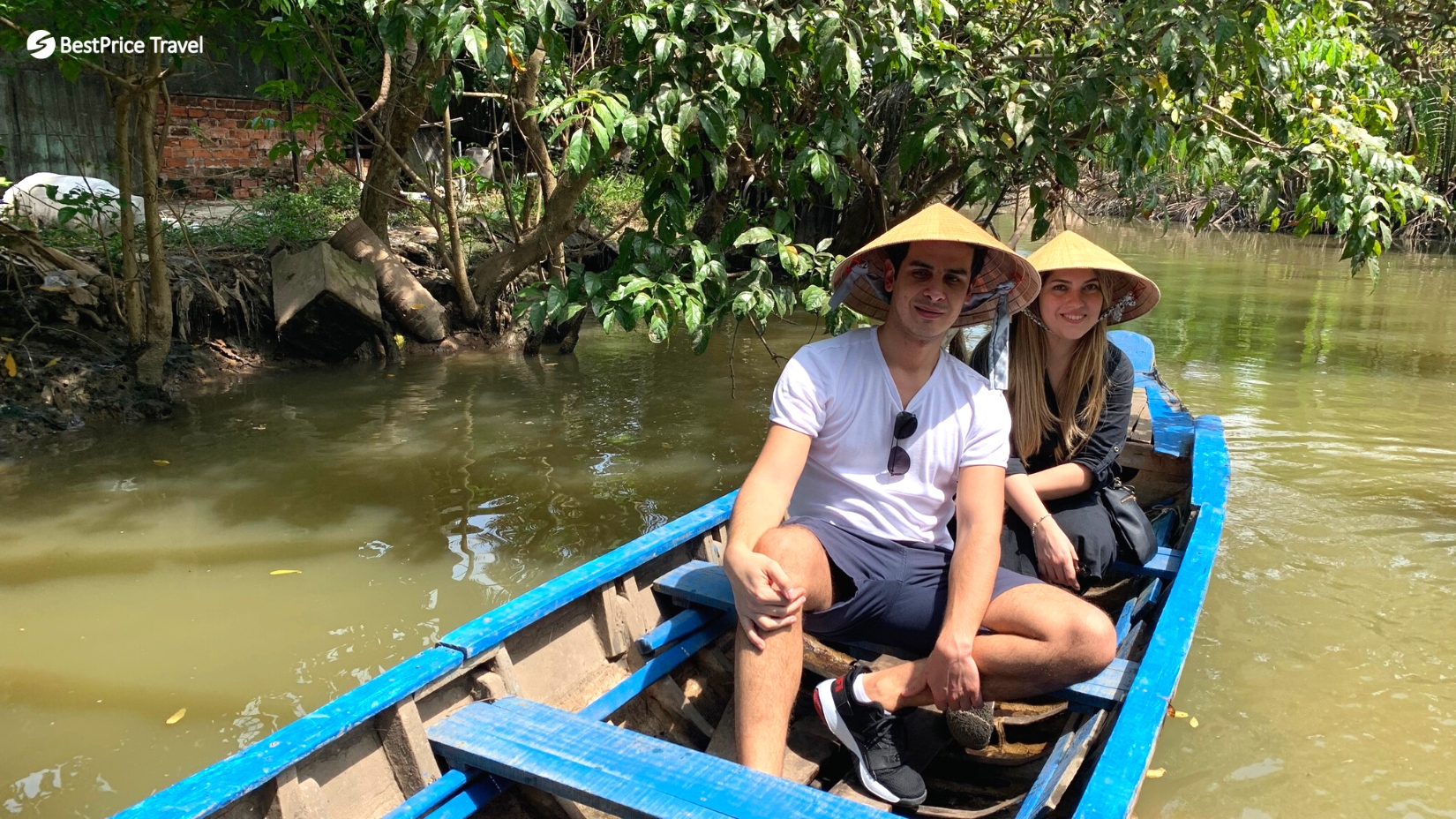
Mekong Delta
Day 25: Can Tho - Cai Rang Floating Market - Chau Doc
In the early morning, you need to wake up and visit the Cai Rang Floating Market on a boat and sampan, then head to Chau Doc.
Cai Rang Floating Market
Cai Rang floating market is one of the largest floating markets in the Mekong Delta. The best time to visit the floating market is from 5 A. M to 8 am. That is the bustling and busiest time of the market. Hundreds of boats gather to buy and sell goods in crowds. Each boat has a bamboo pole with a length of 3m - 5m hanging all kinds of goods to invite buyers. Come to visit the market in the morning, you will be able to immerse your senses in the sights, sounds, colorful lifestyle, and taste of the Mekong river.
You then travel to Chau Doc to wait for the next day's speedboat to Chau Doc.

Cai Rang Floating Market
Chau Doc
It is a place of a variety of rural cultures and peaceful landscapes. Chau Doc locals rely on farming and fishing for a living. You may see many rusty houses floating on empty metal drums of locals, in which they live and practice aquaculture. The beautiful image of people feeding the fish right at their homes and big nets standing nearby is undoubtedly worth your while to enjoy.
5 days in Cambodia
Day 26: Chau Doc - Phnom Penh by Speedboat
Today, you will take a speed boat to cross the border to Phnom Penh city in Cambodia
Phnom Penh
Phnom Penh is the vibrant bustling capital of Cambodia. Situated at the confluence of three rivers, the mighty Mekong, the Bassac, and the great Tonle Sap, the city has plenty of places to see from the historic sites and architecture to the boutiques and bistros dotting the side streets. Phnom Penh is also a famous Cambodian hospitality city, awaiting tourists to visit.
Day 27: Half-day Phnom Penh - Road Transfer to Siem Reap
Today, you will have a half-day Phnom Penh city tour with must-see places like Independence Monument, Royal Palace compound, Silver Pagoda, National Museum, and Wat Phnom in the morning, then get transferred to Siem Reap in the afternoon.
Independence Monument
It is an Angkorian-style tower with a peculiar-looking but unique style, located in the heart of the capital. It was built in 1958 after the country won its independence from the French. It is the place to memorize the Cambodian patriot who died for the country.
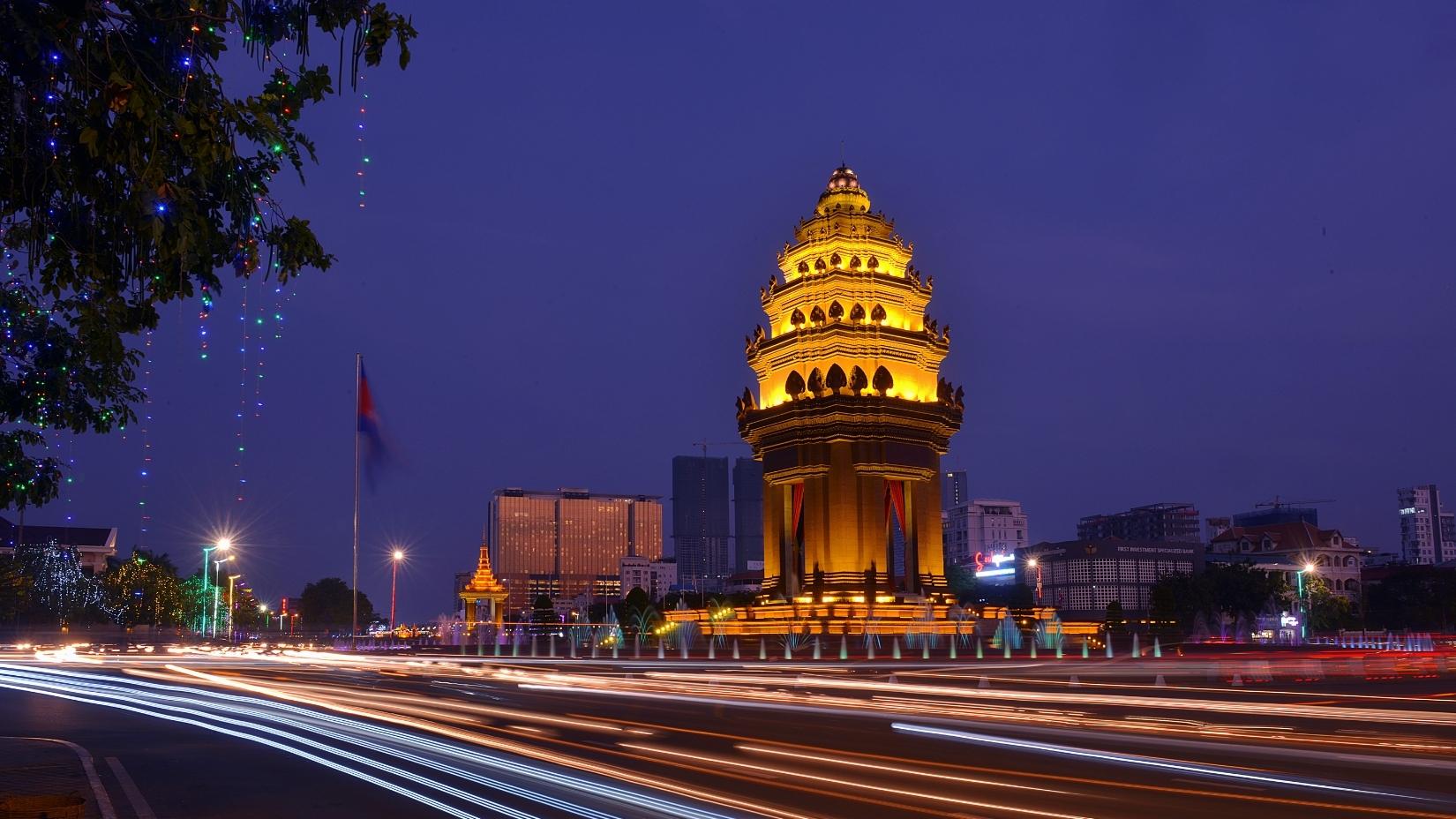
Independence Monument
Royal Palace compound
The Royal Palace is one of the most splendid architectural achievements in Phnom Penh. It is a complex of buildings that serves as the royal residence of the king of Cambodia and a fine example of Khmer architecture with a slight French touch.
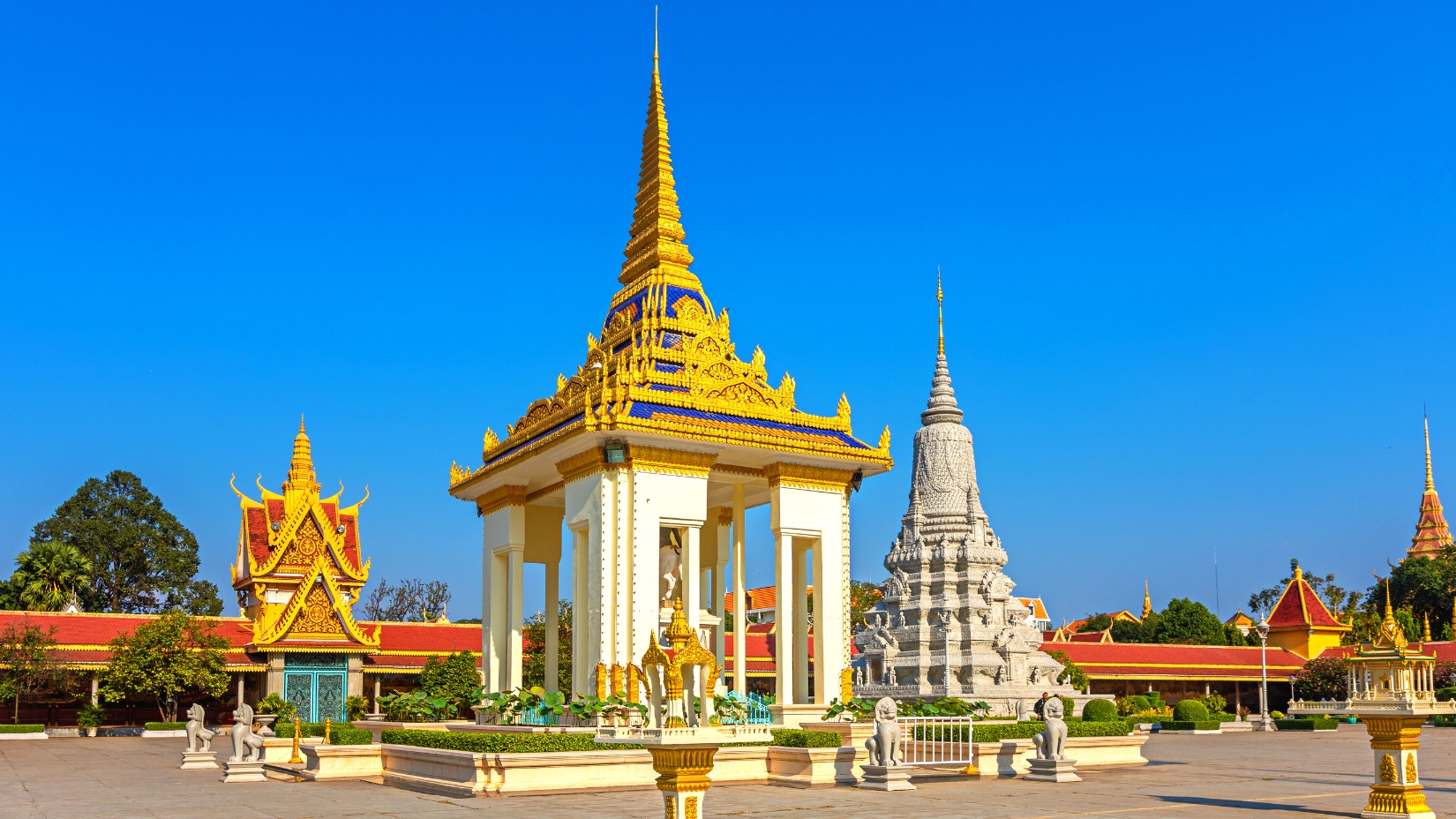
Royal Palace
Silver Pagoda (The Emerald Buddha temple)
Silver Pagoda is located in the southern portion of the Royal Palace complex, based on the Cambodian architectural style. It is the place where King worshiped, prayed, and practiced every Buddhist Silas Day. It now displays plenty of Buddha Statues that were decorated and made of diamond, emerald, gold, and silver. People call the temple the Silver Pagoda because of the 5,329 genuine silver tiles that cover the floor.
National Museum
The National Museum of Cambodia houses one of the world's greatest collections of Khmer cultural material including sculpture, ceramics, and ethnographic objects from the prehistoric, pre-Angkorian, Angkorian, and post-Angkorian periods. The Museum promotes awareness, understanding, and appreciation of Cambodia's heritage through the presentation, conservation, safekeeping, interpretation, and acquisition of Cambodian cultural material. It aims to educate and inspire its visitors.

National Museum
Wat Phnom
Wat Phnom is the only hill in town with sacred sites. Many people come here to pray for good luck and success in school exams or business affairs. Climbing the stairs to the top of the hill, you will have fabulous views of the city below.
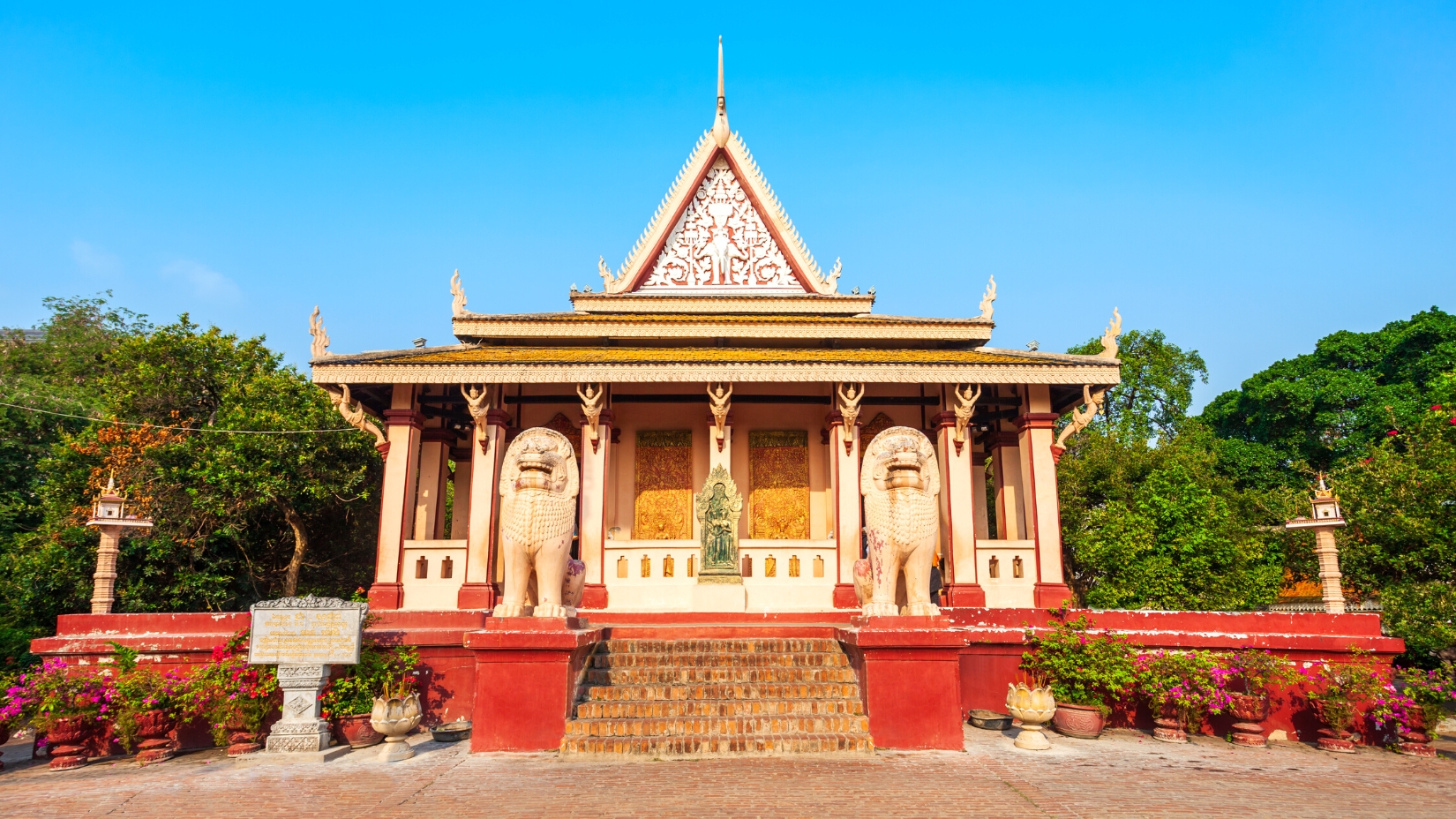
Wat Phnom
After a half-day city tour in Phnom Penh, you will hop on the 6-hour bus to Siem Reap, the gateway to the UNESCO World Heritage.
Day 28: Angkor Wat Complex Full-day
Today is a full-day tour with a visit to the Angkor Wat complex.
Ta Prohm
One of the most famous temples in Angkor, the Ta Prohm is known for the huge trees and the massive roots growing out of its walls. Unlike the other monuments of Angkor, Ta Prohm was abandoned and swallowed by the dense jungle, but still retains much of the mysteries, so it was once used as a location to film the famous Hollywood film, Tomb Raider.
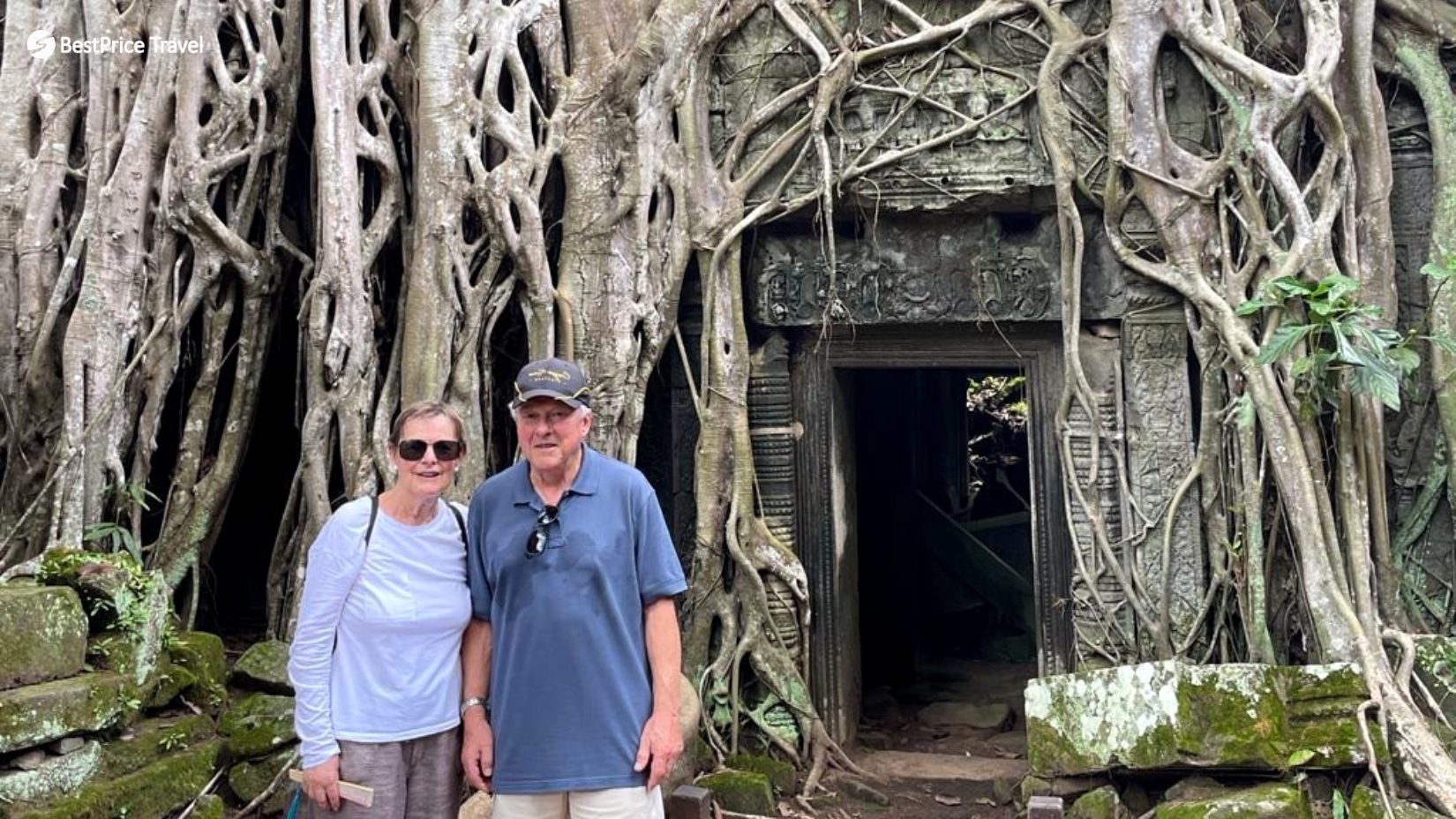
Ta Prohm
Angkor Thom
Angkor Thom is the last capital of the Khmer Empire. It is famous for its series of colossal human faces carved in stone, the impressive Bayon Temple, the Royal Enclosure, Phimeanakas, the Elephant Terrace, and the Terrace of the Leper King. Bayon is a mesmerizing centerpiece, it has three levels including several galleries on the first base, historical and religious bas-reliefs on the second, and a central circular tower in unique Khmer architecture on the last base. You will find Bayon the most fascinating with 216 smiling faces of Avalokiteshvara peering down at you.
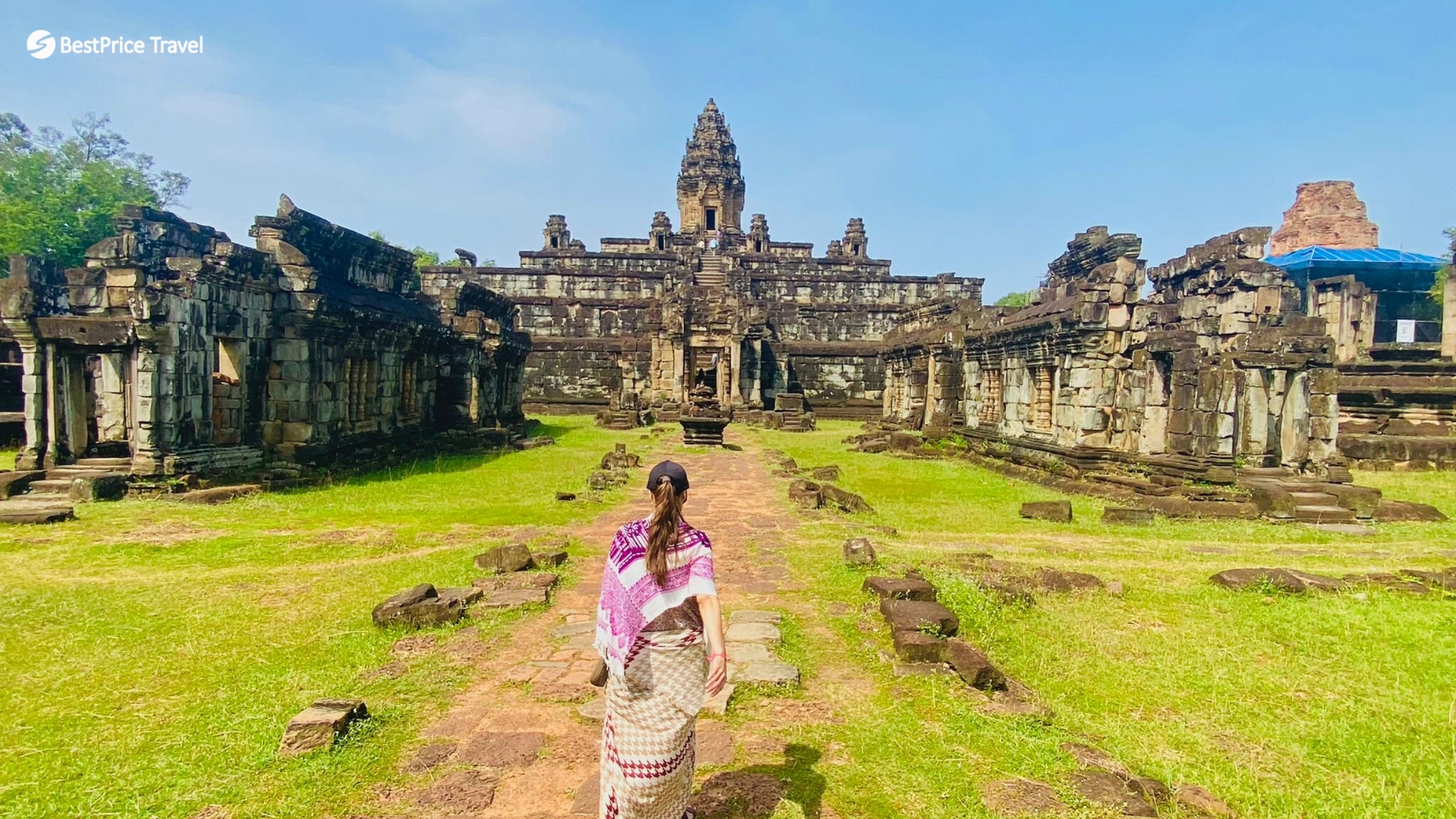
Angkor Thom
Angkor Wat
Angkor Wat is the most famous of all the temples on the plain of Angkor. The temple complex covers 81 hectares and is comparable in size to the Imperial Palace in Beijing. This is one of the most important monuments in Cambodia, considered to be the pinnacle of Khmer art and architecture, and appeared on the national flag.
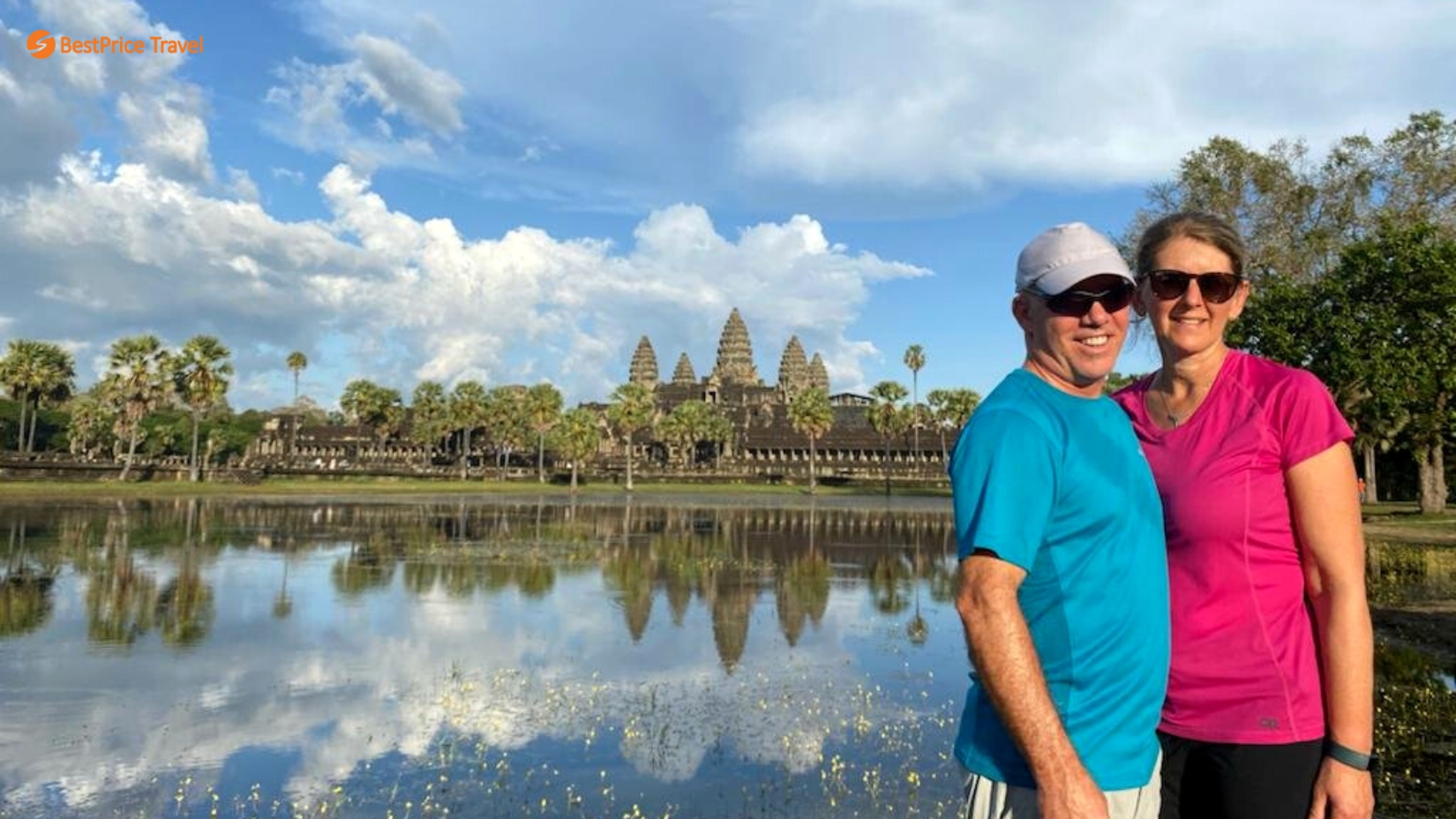
Angkor Wat
In the evening, join the Khmer Traditional Dance Show at Amazon or Kulen II restaurant.
Day 29: Siem Reap - Banteay Srei - Tonle Sap Chong Kneas Floating Village
Today, we will have a full-day tour of Banteay Srei and Tonle Sap Chong Kneas Floating Village.
Banteay Srei
Banteay Srei is the Citadel of women, considered a classic pearl in the crown of Khmer art. The special charm of this temple lies in its remarkable state of preservation, small size, and excellence of decoration.
Banteay Samre
Banteay Samre was established in the third quarter of the 12th century. It is one of the most complete complexes at Angkor due to restoration using the method of anastylosis. Within Banteay Samre, visitors would enjoy its interior with a paved moat which when filled with water also gives a mystical and peaceful sensation.
The Tonle Sap
It is about 16 km from the southeastern city of Siem Reap. This is a relatively small village, provides a good insight into the Tonle Sap village lifestyle. The village is almost entirely in fishing and related activities.
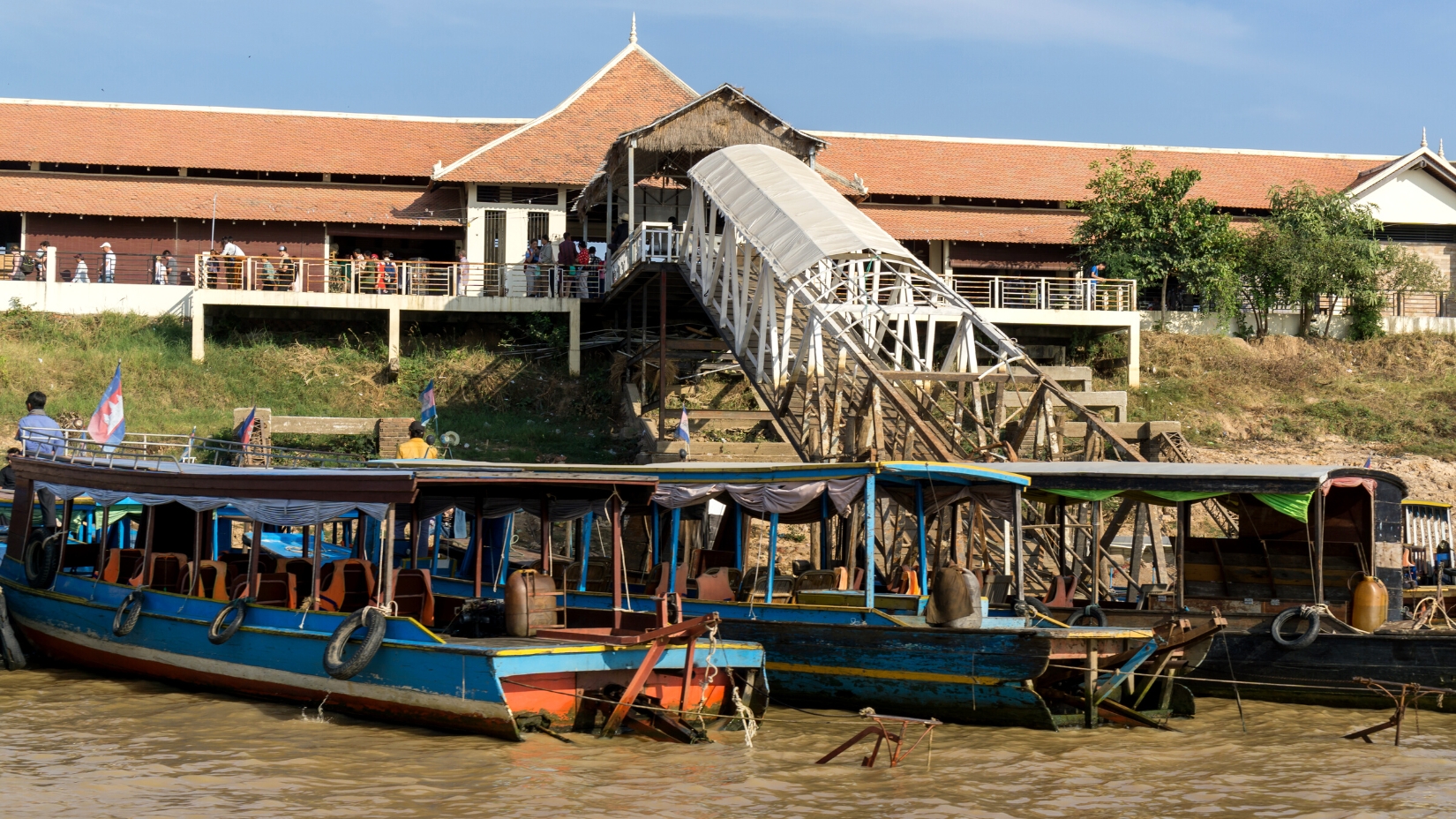
Houses on the Tonle Sap river
Before returning to the hotel, you will stop at Old Market. You will find artifacts, gold and silver jewelry, precious stones, silk, stone, and wood carvings, as well as shirts, CD, and other memorabilia.
Day 30: Siem Reap Departure
Leisure time before your departure flight out of Siem Reap.
30 days of traveling and you get a lot of things you have not expected. Every day, a new adventure is waiting for you to explore. “Travel is the only thing you buy that makes you richer.” Everyone wants to be richer, so do not hesitate to join our 30 days Vietnam, Thailand, and Cambodia trips.
Jenny Tran
(Image source: BestPrice Travel & Internet)
Questions & Answers (2)
What is the price for two,what for single
Price for single or double share depend on your travel date, hotel class please share more detail so we can make a quotation for you.
30 days how much for solo please
Hi! At present, we provide the longest travel time for Thailand, Cambodia, and Vietnam is 28 days, you can see the itinerary at
4 weeks in Thailand, Vietnam and Cambodia - from $3300 (exclude solo traveler surcharge).
Also, if you keen on a 30-day trip, we can help to customize the itinerary for you.
Please check your email for more information from our consultant.
